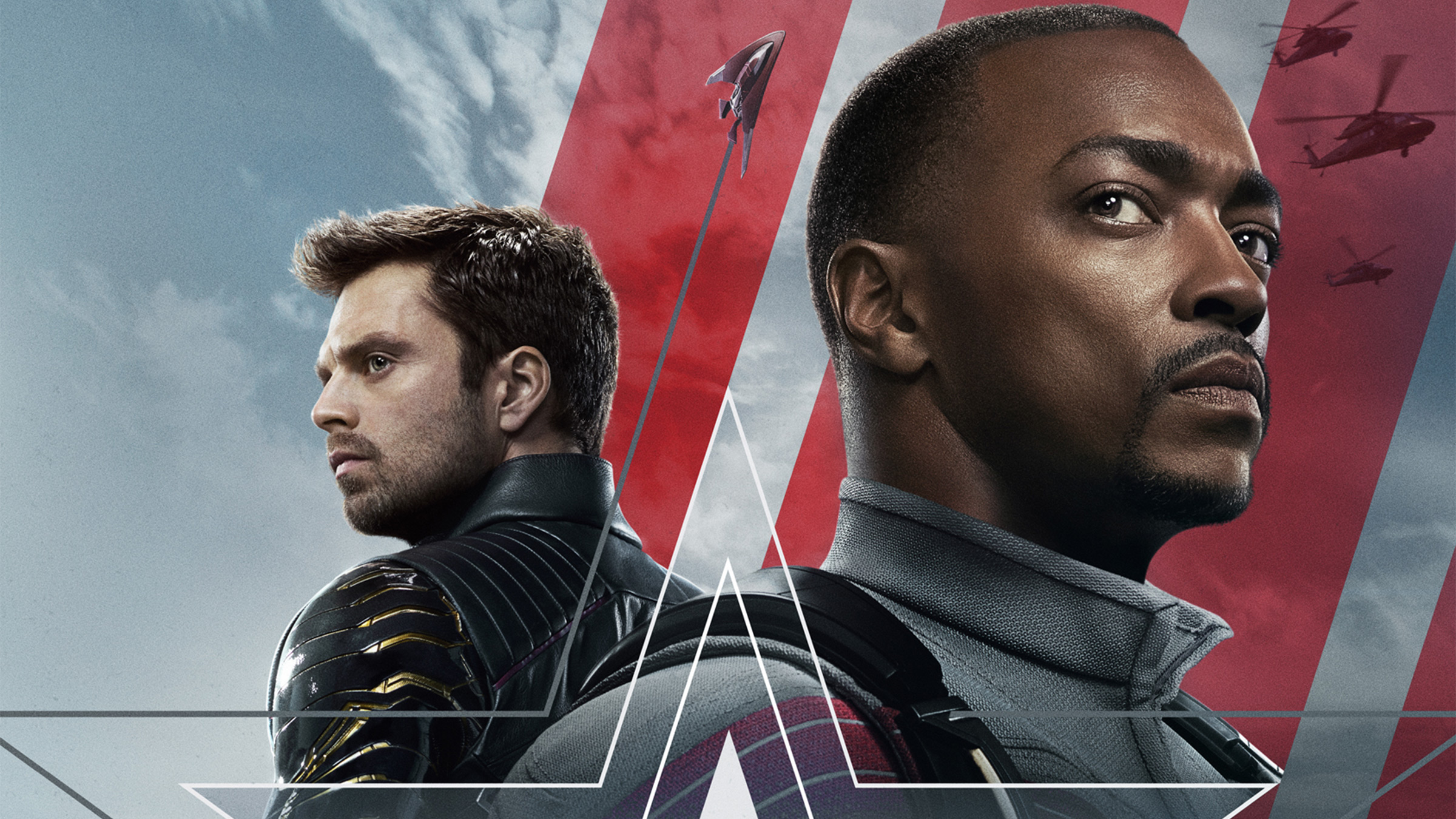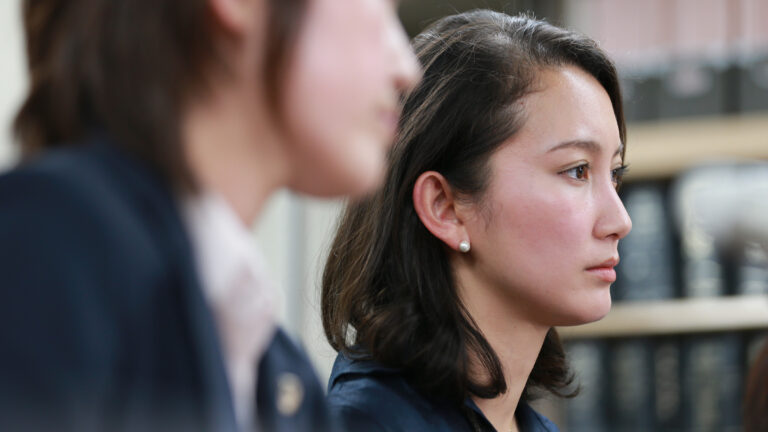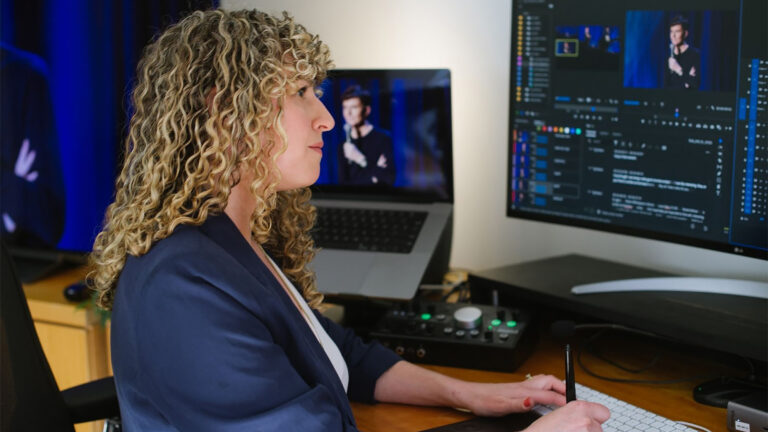For Art of the Cut episode 104, we’re speaking with editors Rosanne Tan, ACE, and Todd Desrosiers about picking up the shield from where it was left at the end of Avengers: Endgame and taking on the edit for Marvel’s limited series, The Falcon and the Winter Soldier.
As well as cutting the latest addition to Marvel’s ever-expanding universe, Rosanne has edited series such as Mr. Robot, NOS4A2, Seven Seconds, Homecoming, and Time after Time. And Todd brings a wealth of experience from series like Tales from the Loop, Legion, NOS4A2, The Umbrella Academy, and Fear the Walking Dead.
So we sat down with them to find out what it’s like to help keep the Marvel momentum moving.
Listen while you read…
HULLFISH: Did you two work on NOS4A2 together? Or were you both on at separate times?
TAN: It was sort of separate because Todd did the pilot, the first episode, and I came on board for episodes seven and eight. We were there at the same time, but he was leaving and I was just starting dailies. Then, we worked together a long time ago on The Following, and I was an assistant editor and he was an editor. I didn’t assist him, but we were on the same team.
DESROSIERS: That’s the way-back machine. That’s right.
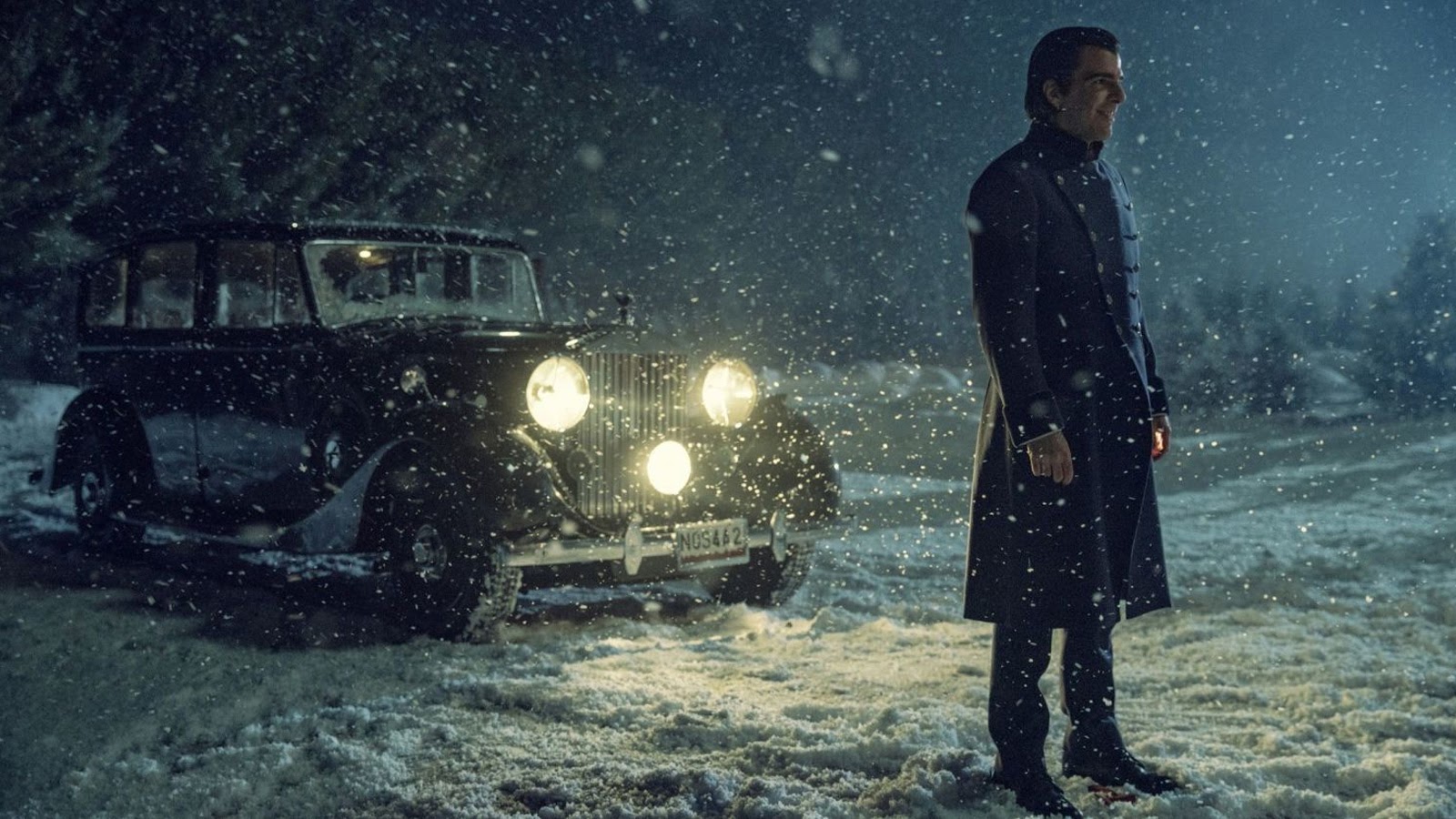
HULLFISH: Does that familiarity help? Do you know how somebody thought to give you a call for this project?
DESROSIERS: For me, the familiarity definitely helps. If you’re ever on a show and you think, “Oh great, I get to work with them again,” that’s awesome because there’s already so much common ground and you already fought some battles or fought technical problems, so you’ve already been there and you know each other and there’s a shorthand, which is really good.
But this one, coming on The Falcon and the Winter Soldier was through NOS4A2 because Kari Skogland directed the pilot episode, and that’s what I had done with her there. She ended up recommending me over to the good people at Marvel, and so I had a meeting with everybody, Victoria [Alonso], Nate [Moore], and Zoie [Nagelhout]. I think the combination of all those things but primarily having a good working relationship with Kari was a big help as far as getting on Falcon.
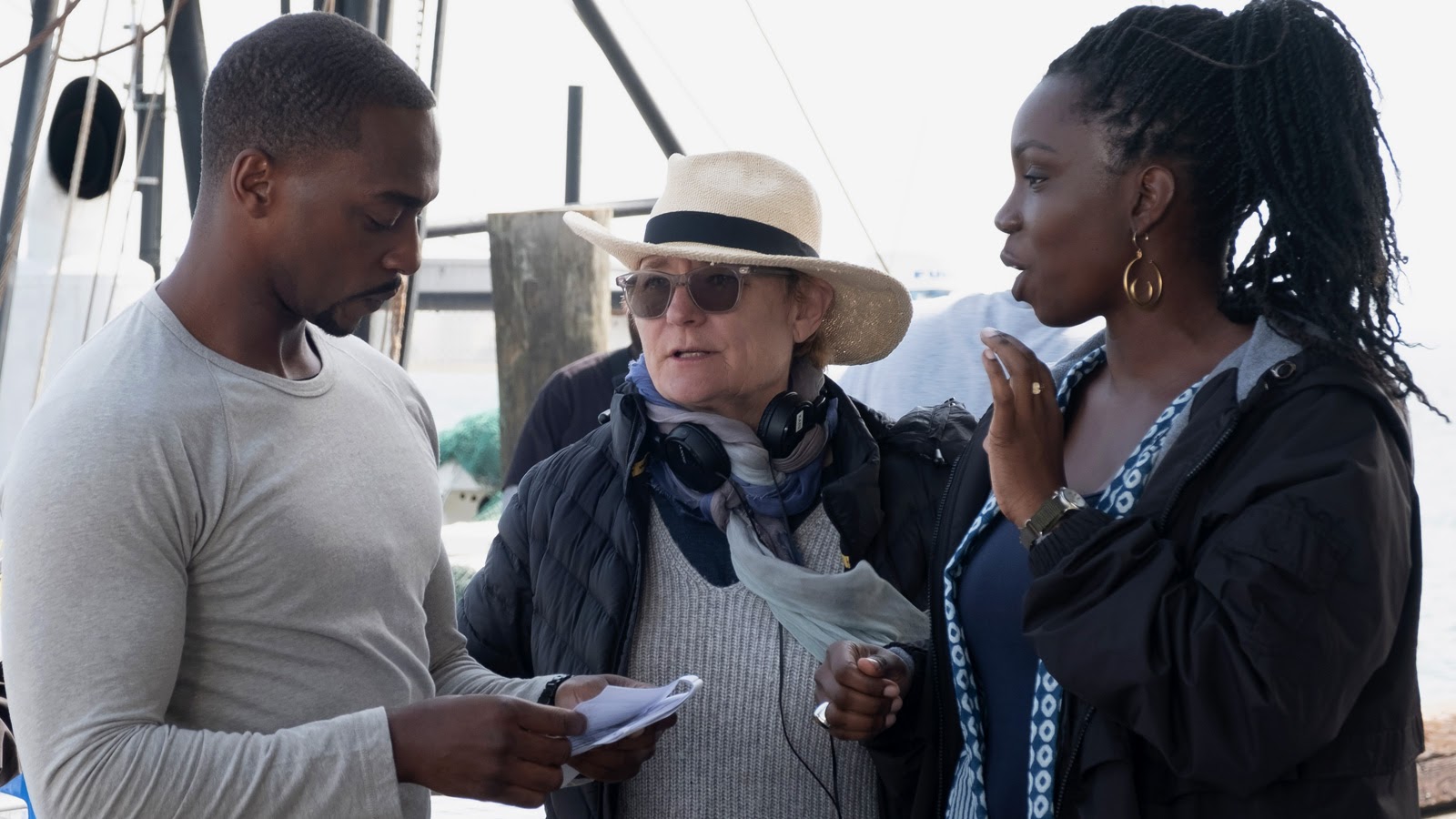
HULLFISH: Do you think that was it for you, Rosanne?
TAN: No, mine was a little different. I actually didn’t work with Kari [on NOS4A2] because I was episode seven and eight. She only directed one and two, and I worked with the showrunner, Jami O’Brien. Kari asked Jami for recommendations because she was compiling a group of editors together, Jami O’Brien recommended me. So, I’m very thankful for Jami’s recommendation. Then, I got the interview and I guess the rest is history.
HULLFISH: Nice. You guys also work with Kelley Dixon, ACE?
DESROSIERS: Correct. I had known Kelley through people, but we had never worked together until this. Some people I know had worked with her, but we never really had a chance to meet.
TAN: I would see her at events. I worked on a couple of AMC projects even when I was an assistant and then as an editor, and I would hear about her name through a friend of mine, Skip Macdonald, ACE, and then you see each other at ACE events or places like that, and then finally we got to work together on Falcon.
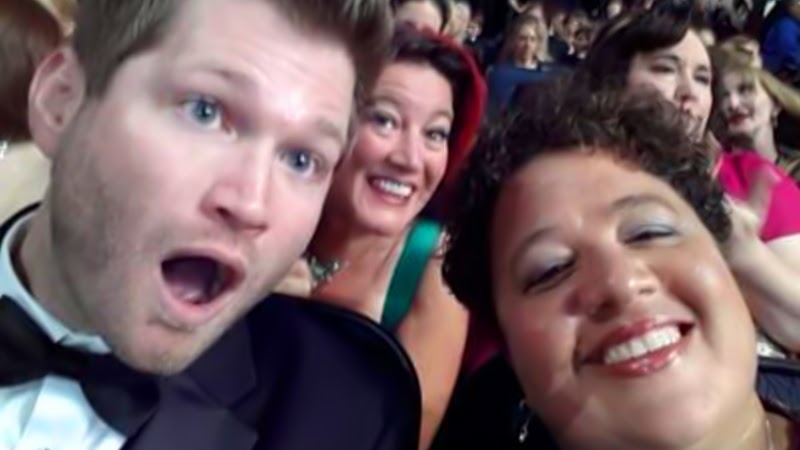
HULLFISH: I’ve talked to Kelley a couple of times and that’s one of those things that she mentioned to me is just that ability to introduce people and try to have it be a case of saying, “Oh, let’s talk to Kelley’s friend, Rosanne.” It’s nice that you can go to an event like that, meet somebody, and have somebody that you know introduce you to other people. Do you feel like that’s a lot of the way connections happen?
TAN: I feel this industry is all about people. For example, my assistant prior to my current assistant, Caroline Wang, I met through another editor-assistant that I met years ago, and then somebody recommended him. Then, for Caroline Wang, I actually met her at a book signing for an ACE internship teacher, Lori Coleman; it was her book signing and then Caroline Wang was there. Then, years later, we connected and then she was in another group that I was in. So, sometimes I think it’s definitely who you meet at different events and who you get recommended. It’s definitely about people.
DESROSIERS: Yeah, it’s such a word-of-mouth industry. You’re only as good as your brand, if you want to go that route. I just got a call recently that said, “Hey, we’re doing a pilot. Are you available?” I said, “Ah, I’m already on something. I can’t, but if you need me to, I’ll look around and ask.” Then, who am I going to recommend for that pilot? I don’t want it to be someone that I don’t think can do it or who I don’t really know.

So, you’re only as good as your last job, I guess, but also in terms of being a good person and being capable, that goes such a long way. What I mean by your brand is that you have to be able to be counted on in pressure situations once you get to the level of a Marvel Studio show or something. I got my first real big shot at anything only because of a word-of-mouth to somebody else and they trusted that I was going to do the job well. So, it’s like a pay-it-forward.
TAN: Yeah, you just never know. For example, how I got into the Kevin Williamson camp as an assistant editor then editor, it was through word-of-mouth, and then I interviewed with a separate group of people who said, ” Your schedule isn’t working with us, but we’re going to recommend you to this team.” So, then I actually was interviewing for The Vampire Diaries to fill in. With my schedule, I was only limited with this month and then they said, “Actually The Following needs somebody.” Then, it became the place to be. You just never know.

HULLFISH: Is there a style of editing from Marvel? Or if someone new were to come onto the show, would you say, “We don’t like pre-laps,” or something? I know many shows have either the showrunner or someone else who likes or dislikes certain things. Is there anything like that with Marvel?
DESROSIERS: It’s funny, I would normally say yes, but then WandaVision came out and rewrote what our little show might be, and it does such an amazing job with that. But to answer your question, I don’t think so. They won’t ever put those blinders on you, they don’t want that. But they might say, “That’s really great, but let’s steer it back here,” or something like that because I feel like there’s a Marvel experience.
I’m coming at it from: I have an 11-year-old now, but early on he loved Marvel movies, we’d watch them together as a father/son rite of passage. He’s a huge Black Panther fan. I was approaching it like that. I’m wanting to create what I, as a fan, would want to see and what I’m used to, and there’s a canon of all those movies that came before you that you want to honor, especially if you’re dealing with the Captain America aspect and storyline. That was really my approach to it.
For The Falcon and the Winter Soldier, I’d Watch Captain America: The Winter Soldier religiously sometimes just to get reinspired. Basically, that would help get me into the right mindset for what the Bucky aspect is but also the Captain America aspect; and the film grammar, if you want to use that term, for what Marvel might expect. Again, they weren’t saying, “Oh no, you can’t do any of that. No pre-laps or no this or no that.” I think they want you to try it and go outside the box, but at the end of the day, you’re still creating something that fits within their worldview.
HULLFISH: Did you find a film grammar that you thought was something that you could follow?
DESROSIERS: Yeah, I guess it would be more of a classical style for this. I think if you want to talk about how it was all supposed to happen and unfold, Falcon was supposed to be the first one out on Disney+. Nothing was ever spoken, this is just something I internalized and thought about is: “This is the very first one for Marvel coming out for Disney+. It’s really important.”
TAN: Lots of pressure.
DESROSIERS: Lots of pressure. So, we’re going to do better than your expectations, but we’re going to meet your expectations for what this is supposed to be. So, my cutting style was similar to what Jeff had already laid out.
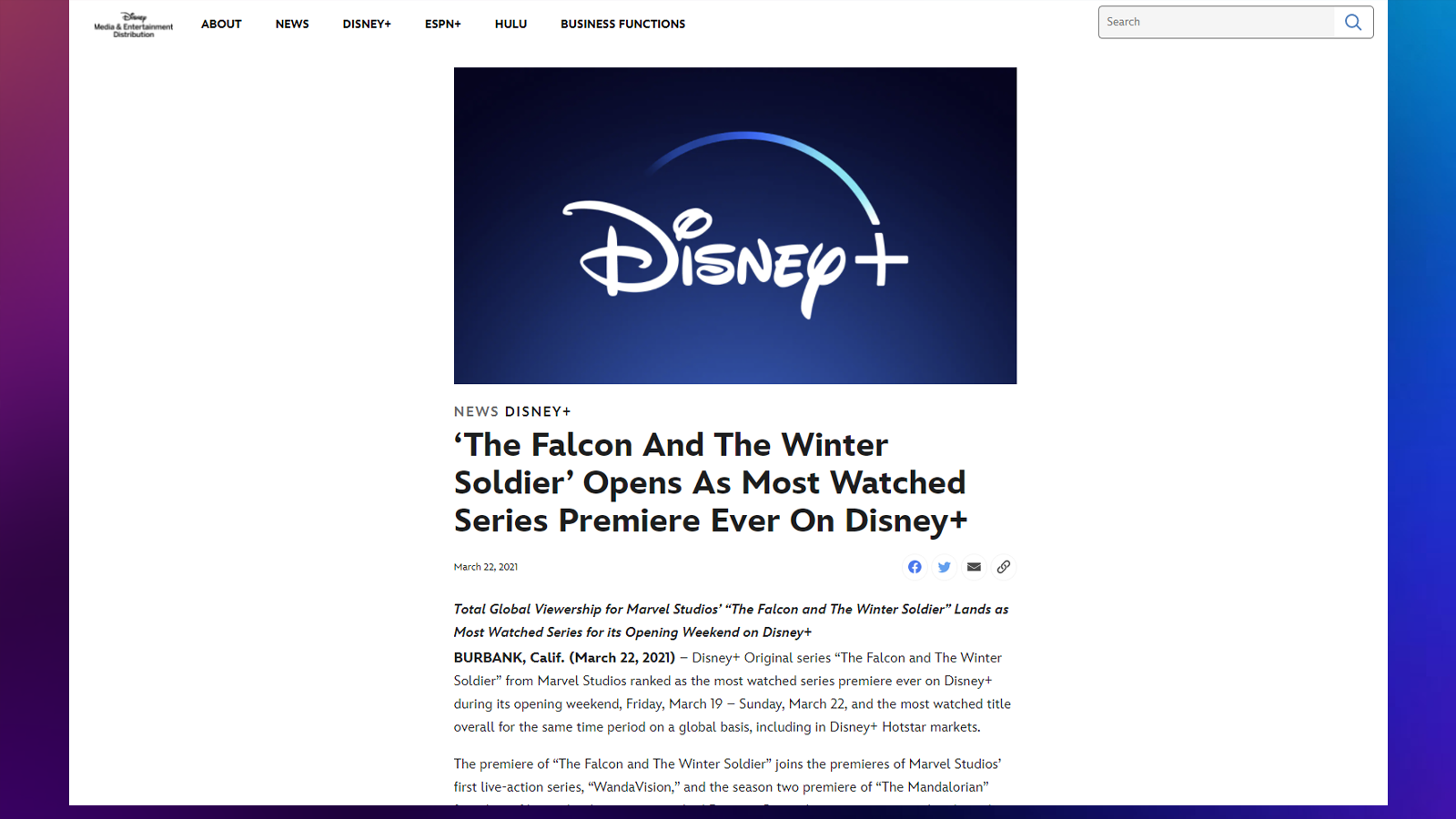
HULLFISH: Jeff Ford?
DESROSIERS: Yeah, the Maestro.
TAN: The Maestro, indeed. For me, we were never told, “Oh, don’t do this, don’t do that.” Also, I feel like it’s a very filmmaker basis type of situation per project. It also depends on what Kari is liking, and then when we show it to Nate Moore and Zoie, who were our executive producers, and also when Kevin [Feige], Louis [D’esposito], and Victoria [Alonso] see it, it just depends. So, we were just basically cutting from what we know. Also, I was inspired by the movies and because right before I started I was watching it down chronologically trying to follow the story. Before I interviewed, I actually was a big fan of Captain America and Ant-Man, so I only watched those two.
Coming into the job, I just basically started from the beginning. I went on Google and followed the fans who said, “This is how you should go in order just to know the story.” Then, I guess from watching all that I thought, “Okay, I need to do a good job to honor these movies.” Like Todd said, at first we were told that it would be the first project [on Disney+], so it was a lot of pressure and we wanted to do a good job.
Then, when the dailies come in, you think, “Okay, here we go,” and it’s so much fun when you get the dailies. You think, “I can’t believe I’m here.” Also, when the big action sequences come in you think about the movies you watch and you want to honor that, and you want to honor what Jeff Ford did in Captain America: The Winter Soldier many, many years ago. I think it’s a challenge, and it’s a lot of fun.
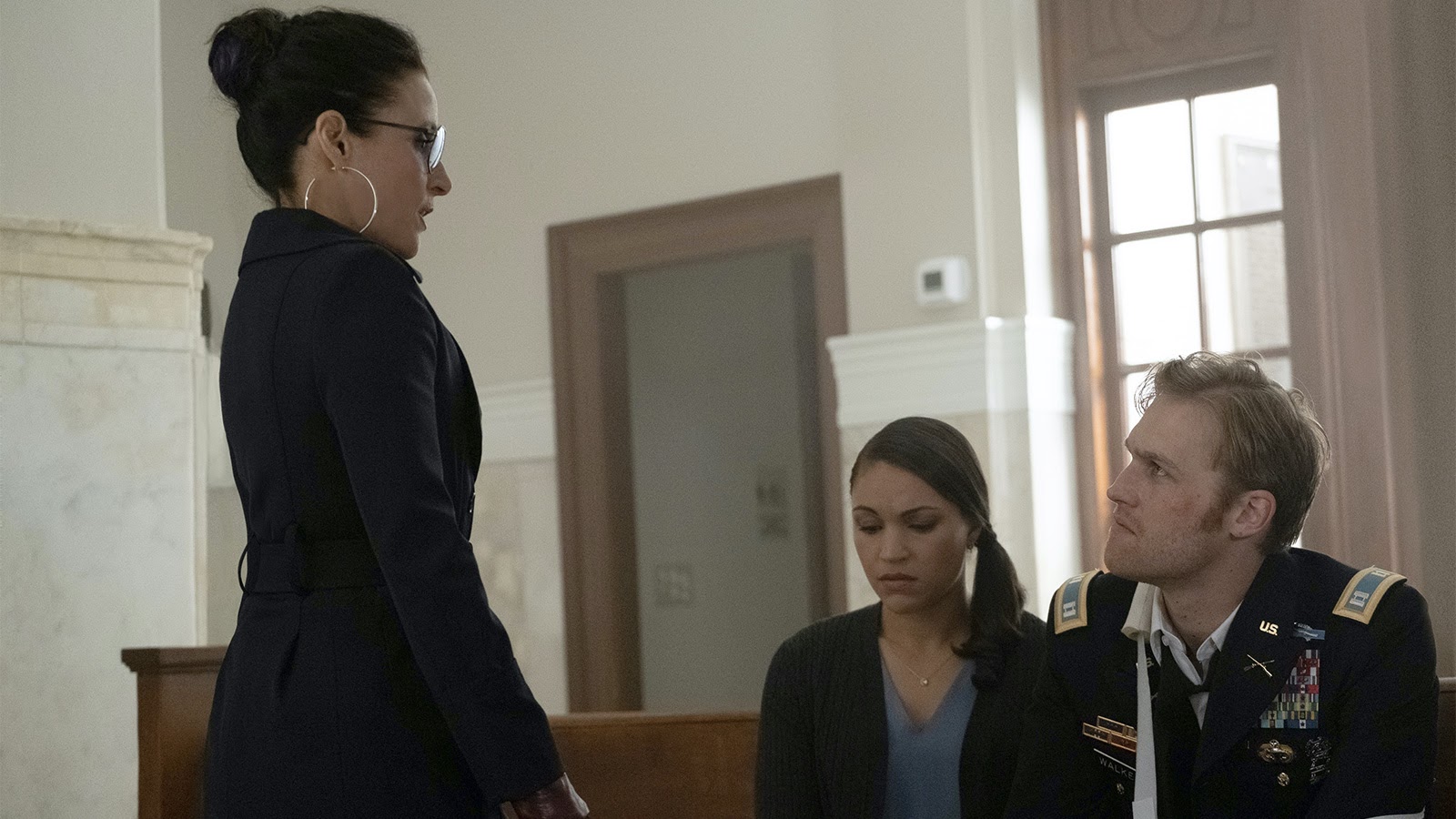
DESROSIERS: There’s also Kevin and Victoria, and they’re sort of tastemakers with their sensibilities too, but it always comes from a logic point. There’s one scene in episode five where Walker was on trial, and there’s an early version of doing some overlapping cuts of him arguing back at them. It made it more psychological, but what ended up happening was they weren’t saying, “Oh, that style doesn’t work for Marvel.” It was more like, “Well, we don’t want it to confuse and make people think that the serum is causing him to be psychological here.” So, those reasonings for it would then push you back. They still liked it, but we would reign it back in and just have it be about his anger and a little bit different than possibly a serum. So, it’s all from that basis.
Kari was also definitely really trying to experiment here and there where she can because that’s how she’s made her name. The original pilot for NOS4A2 was crazily experimental and cool, but at the end of the day, I think they wanted to make it be a little bit more like Stephen King, 1980s, to honor that kind of feel and vibe, and that’s what it ended up becoming. So, we had felt around with it too.
HULLFISH: Does it help you at all to have that kind of a canon as an editor, or is it difficult? Because a lot of times, we’re telling a story from scratch. There’s no backstory that’s written down, the fans don’t understand the back story, but with this you’ve really got a fan base that knows the canon. What kind of pressure does that put on you?
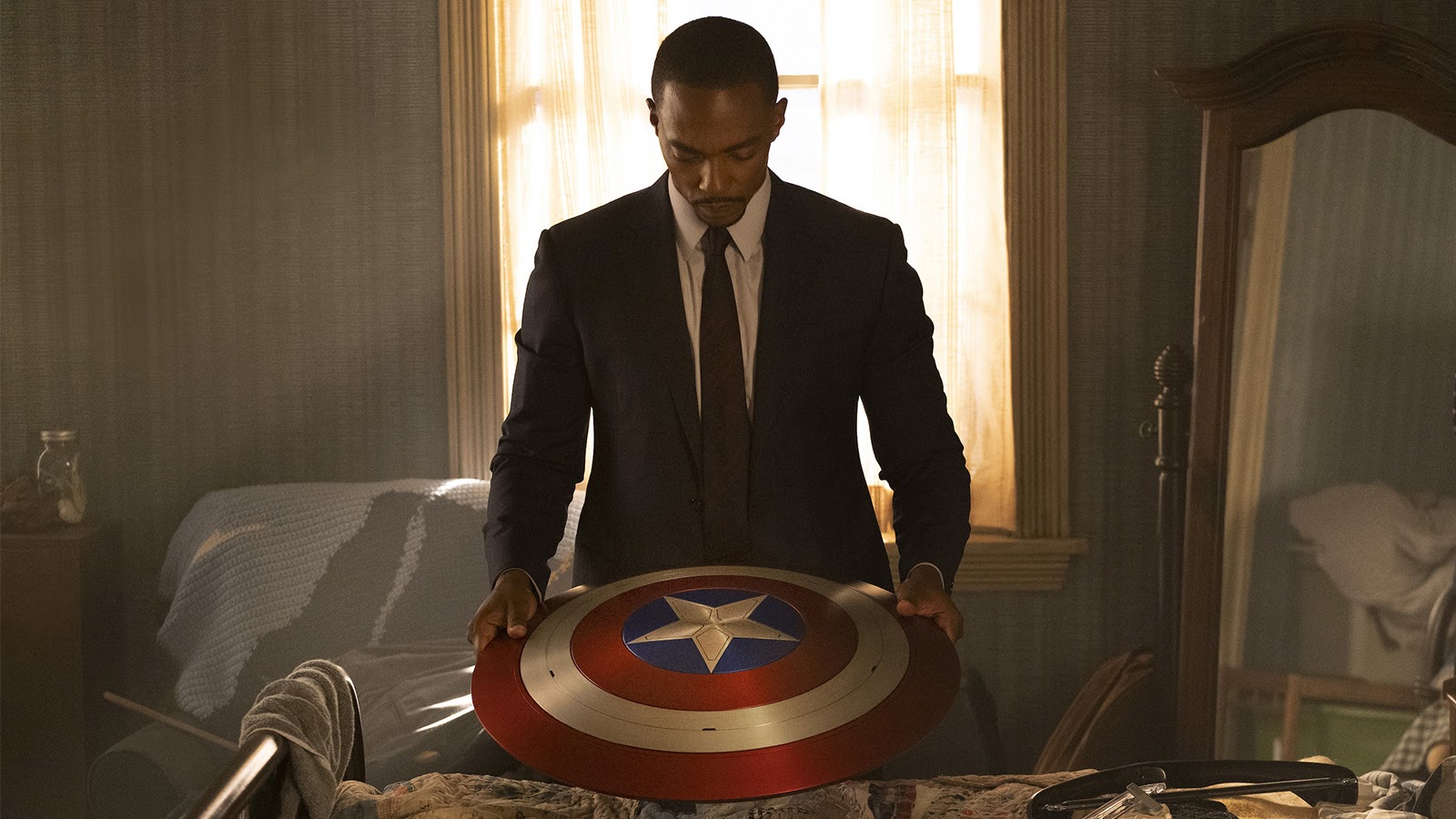
TAN: I think it’s a lot of pressure since this is something that many millions of fans have watched, especially with where we left off at Avengers: Endgame. There’s a huge hype behind it. I think also, Falcon and Winter Soldier are such beloved characters. They’ve had that buddy-buddy relationship, so it was cool to see that and make sure that we honor their buddy-buddy moments. Also, we’re telling a new story too: basically where Sam Wilson is coming from. So, that’s a whole new side that fans may have not seen. They saw a little bit of it in Captain America: The Winter Soldier, but now it’s exploring different areas. Again, we’re trying different things there. I think there was a lot of pressure when it’s something that’s so loved by all the fans.
Earlier, Todd was saying about Kevin, Louis, and Victoria, they care a lot about stories. So, for example, if something doesn’t work out, we’re laying it all out again and trying to figure out what’s best for the story. So, if it doesn’t work, it’s never going to finish that way. We’re going to rethink and then rework this scene.
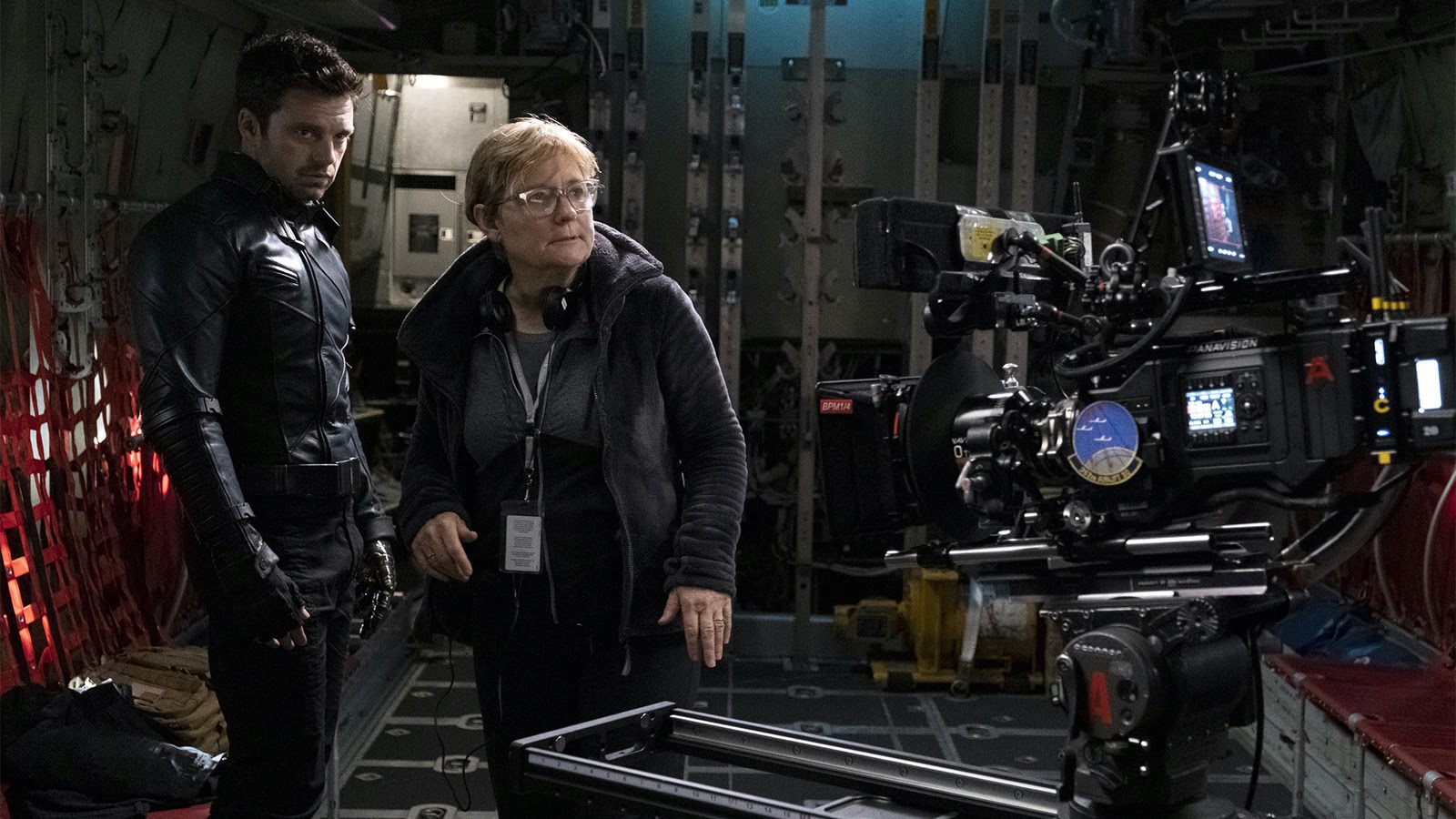
DESROSIERS: Yeah, for sure. I think there is a lot of pressure from the fan base and all the work that came before, but I think it’s also helpful because it at least helps you trace the steps. You might think, “Well, then this doesn’t feel like Bucky would react this way based on who Bucky was,” et cetera. Stuff like that. So, it was a blessing and a curse I think, but mostly a blessing. The curse being you don’t want to mess up.
In my interview, I wanted to make sure Victoria knew that I didn’t want to be part of the team that messed it up because I really revere it and I think it’s something special. The quality and the sense of humor, how it doesn’t take itself too seriously and yet it’s such a popular and, at times, very serious emotional franchise. It’s magical what they have been able to do, capture, and keep quality-wise going for this many years. The fans caring that much about it is just really a badge of honor for how good they make these things.
I think that’s one of the insane things that I learned at Marvel is that we’re able to do all this.
HULLFISH: I know that in previous Marvel films there’s a ton of previs, and I wasn’t sure with this series whether there was a lot of previs or not.
TAN: It depends on the different episodes, and a lot of times what comes in previs, you see it and you put it in the sequence for now until it comes in, and then it is shot entirely different because of where the actors are standing and different circumstances. So, then you’re using the previs as an idea and then you go with what you have, and a lot of times it’s very different. It’s really cool to have that option to see previs and also ask for postvis. I think that’s one of the insane things that I learned at Marvel is that we’re able to do all this. I guess coming from the dramas I worked on, we didn’t have previs or postvis, and learning the whole VFX thing was basically a whole new thing.
Learning from Jeff Ford, he has the whole workflow down, and I’m so grateful for it because then we learned about when we cut the scene, we get it ready, get it to postvis… Before, it was more like we wait until the end. On Mr. Robot, we wouldn’t worry about VFX till the end when we locked the episode, whereas here it’s always ongoing. So, you get the postvis team talking with you, then you get what you need, and then you put in the sequences, which is such an incredible option to have.
HULLFISH: What do you think that does to your editing, the difference between, say, the way Mr. Robot worked where you didn’t see the full postvis or any kind of postvis until the very end and this where you got different versions of postvis throughout the process?
TAN: I think it just helps it. For example, on Mr. Robot we didn’t have postvis, we had our assistant editors comping for us, and those are the temps. I don’t think postvis existed. We literally will have comps. If we didn’t it was more like, “This is something that will get worked on later. This is a very temp split-screen that we’ll do and our VFX vendor will eventually make it better.” Whereas here you’re actually adding things to tell the story, and whatever’s to advance it actually just helps you, I think.
For example, I can’t actually add a shield. I can definitely have my assistant just help me comp or I’ll do a temp comp and put the right plate into the shot, but that’s all I can do. But having postvis just complements it, I think. It doesn’t slow me down or add, it just helps tell the story and whatever tells the story best is going to be helpful.
DESROSIERS: There’s a steep learning curve when you get in if you’re coming from where we came from. I was on a series that while maybe big, didn’t have nearly the embarrassment of riches that you have when you’re at Marvel in terms of the pre and postvis. That was really helpful to have Jeff come in and let us know the workflow that works best, especially because of COVID and all the shutdowns and all that stuff. Our runway got really short towards the end and it was such a big plane. So, he was really crucial to help us get through that part of the workflow.
At the 11th hour you find out, ‘This doesn’t work. What do we do?’ and you have no time.
It feels like if you were to not have the postvis, for example, and you’re working on these big visual effects sequences, like I worked on with The Umbrella Academy, where at the 11th hour you find out, “This doesn’t work. What do we do?” and you have no time. Whereas you’re figuring that stuff out all along the way, and that’s really helpful. Eric and his team for visual effects and Glenn and Kevin, they were really helpful and instrumental.
Also, The Third Floor, which is the postvis team that really helped us. That way, you know when something is not working, you can figure out a better way to do it, and you have more time especially with gigantic sequences like the ones in this, whether it was in episode one, or the truck fight, or even a small scene that was really difficult which was the shield tossing scene in five.
HULLFISH: I was about to bring that up, that the shield tossing scene had to have been very difficult without postvis.
TAN: It’s like nothing [laughs].
DESROSIERS: Well, they were throwing and catching and they would throw it, then they would hand it, and they would catch it, and that kind of interrupts the flow of the actual scene, but they’re pros at it, so that was fine. But from the beginning, it was such a difficult scene because it was one of the first early scenes I cut and I thought, “Wow, cool. I’m doing a scene with the shield. That’s awesome.”
That’s the point though, you don’t want to make it about the shield. It’s really more about what they’re talking about, and early on I thought, “Okay, I don’t know which tree it’s hitting or if it’s supposed to hit six trees. Does it even do that? How do we arrange that?”
But the important part is: how do we land the story? We’re in episode five, we’re towards the end now. There’s a lot of stuff that’s passed and you’ve got the two guys. The reason for the show is to have these kinds of conversations, and this one is so crucial. So yeah, we had so many different visual effects meetings of saying, “The catch doesn’t feel right,” or, “You see how it shifts on his shoulder? Let’s tweak that.” We got down to a granular level of adjustments, but at the end of the day, we’re all focused on how we make sure that the shield doesn’t overwhelm the point of the scene and their relationship.
TAN: Also, you learn a lot about how to think and imagine when something is not there. I think one of the earliest scenes that I worked on was the finale episode with the helicopter sequence, so it went through many revisions. I was working with Eric Leven and Mike May, the VFX guys, and it’s just cutting blue screens and imagining. I thought, “I’m missing this shot,” and he would say, “Ask for it.” And we would go ask for it with postvis, imagining like an over-the-shoulder from inside the helicopter looking through it.
So, anything that you’re imagining, I just asked for it, and then basically you would just guide them on what you’re looking for and then we’ll put it in, then it’s something that we kept working on.
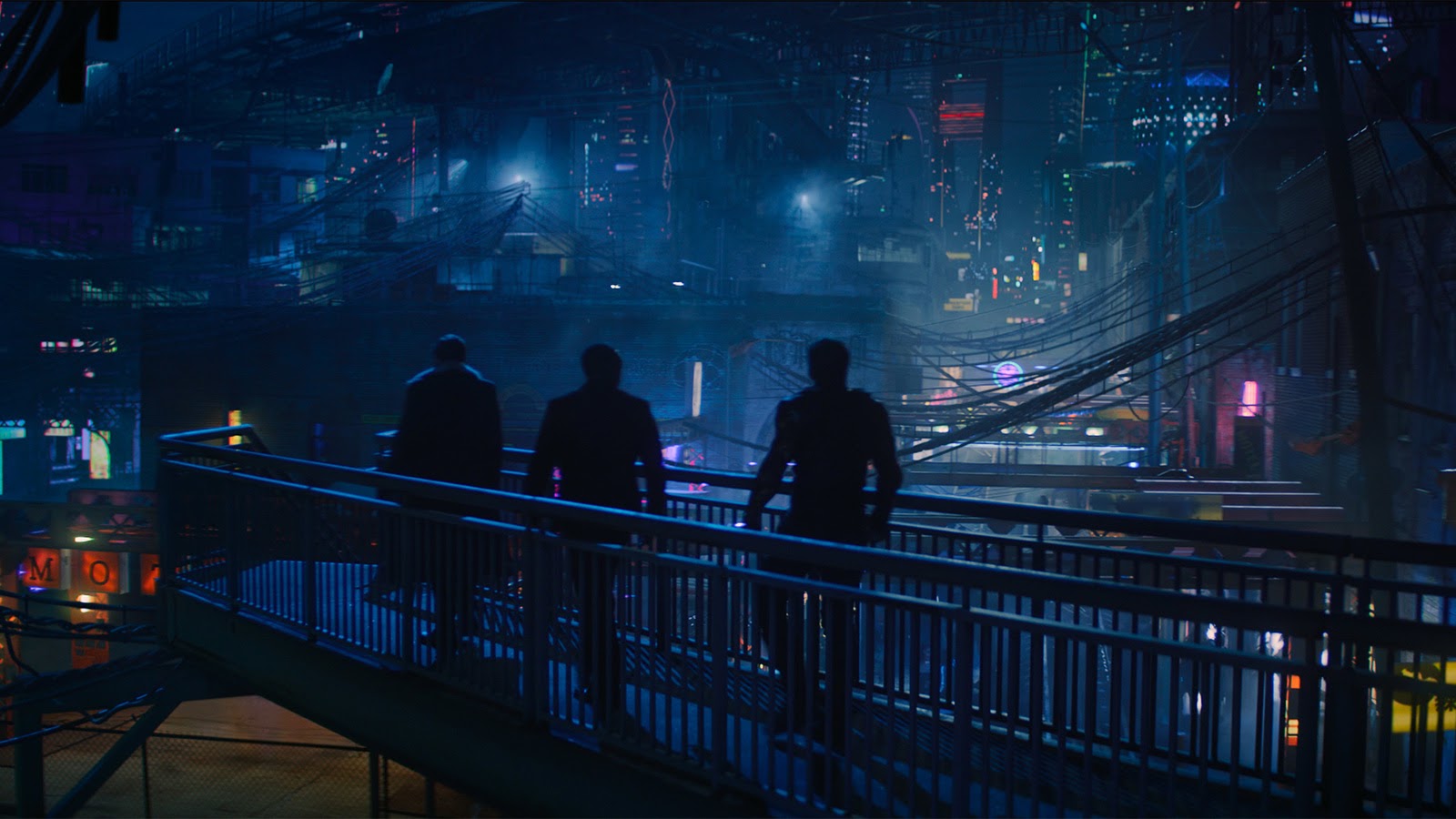
That was pre-COVID shutdown. Then we were at a standstill when that happened, but we kept working on stuff that we did have. So, for example, the plates from New York came, so then they were putting that in. Again, we had many VFX meetings discussing something like, “We want to see the helicopter but without brightening everything too much.” There’s so many meetings like that. It’s because Marvel cares and it’s really cool to see.
Again, when I was cutting that sequence, at the time I thought, “This is all blue screen. This is new to me.” It’s really incredible to see how it ended up. It’s just a lot of work went into it, a lot of people, many different teams were on it vendor-wise. All of us were just constantly working on it. I think that’s the difference with the projects I’ve been on in the past. Here it’s just ongoing, sending back, getting postvis, and then at the same time they’ve turned it over to vendors. Then, they’re working on that and then we have meetings constantly talking about it and improving. So, it’s pretty incredible.
DESROSIERS: It’s always collaborative too, which is really cool. If you have a feeling about it, they’re going to listen to it even though you are so far in and it might be the 11th hour. They might say, “Okay, well let’s tweak it.” Or maybe say, “Don’t worry about it. It’s good.” So, it’s really impressive, as opposed to saying, “No time, no money. It is the way it is.”
TAN: Nothing like that at all. Yeah, and it’s great to pick Jeff Ford’s brain just because he’s been thinking about that for so many years. He could give you an easy answer, too. Again, I learned so much just coming from a non-VFX heavy type world into the VFX world.
HULLFISH: I love how both of you are so comfortable describing what a learning curve there was. You’re both experienced editors, you’ve both worked on great shows before, but there’s nothing wrong with saying, “I’ve never done this before,” right? You just have to say, “Hey, I would love to learn. I’ve never had to do an entirely blue screen sequence.” Talk to me a little bit about coming in on a day when you don’t know what you’re doing.
DESROSIERS: Well, the unique thing about this is it’s not a feature and it’s not a series, it’s something in the middle. That’s why they brought us on and Kari wanted to bring us on because of their lack of experience dealing with the grind of an episodic. That’s not what they do. But, at the end of the day, it was like this gigantic feature. They didn’t really change too much of how they go about their business. This just was more of it. Yeah, it can be overwhelming, but I’ve learned so much from other editors and listening to other editors. You can either fake it till you make it, and sometimes that’s the right approach, but other times honestly it just saves so much time to ask, “Wait, what do you mean? What does that term mean?”
TAN: Just ask. Yeah, just ask the questions.
DESROSIERS: It’s never a wrong question, I think. It doesn’t serve you too well to try to fake it too much. People can tell and a guy like Jeff can tell and Victoria and Kevin and Louis can all tell. They didn’t expect us to…
TAN: …know the VFX-heavy world.
I want to take jobs where I’m learning…otherwise, you feel like it gets boring fast.
DESROSIERS: Yeah, that was something that we’re going to learn on the ground, but they’re okay with it. If you can’t cut it literally and figuratively, then you’d probably find your way out, but fortunately, that didn’t happen and everybody’s there to help. There’s a lot of people there and you can easily ask, “Hey Glenn, tell me about your marker system that you guys are using here because it’s really in-depth and pretty fascinating.” I’m just here to learn, otherwise you get stale too. So, I want to take jobs where I’m learning. If it’s not specifically about editorial workflow, then it’s something else. Otherwise, you feel like it gets boring fast.
TAN: I think, ultimately, it’s about telling a story, and when you come in it’s about what the story is about with the scenes. I think we all come from a world where we are able to tell stories. What’s different is the tools and I’m so glad that they’re not saying, “You must know the VFX heavy stuff.” It’s more like, “Okay, work with this team. They’ll guide you through this.” Again, I think you just have to be humble. For example, I’ll walk next door to Todd’s room and say, “Hey, have you seen this? How do you…” and then the same thing, I’ll call Eric Leven, our VFX supervisor, and ask him questions about, “Hey, I’m not understanding this.” You’re able to do that, and I think that’s really great.
HULLFISH: I love that. Over and over again in Art of the Cut I think it’s been proven that the lack of ego is going to be a beneficial thing as an editor, whether it’s letting the story be the main thing or whether it’s not feeling bad about asking a question that you don’t know the answer to, those are all super important things.
Tell me about your approach to action scenes, as opposed to dialogue scenes. There’s a lot of great dialogue, as you said, it’s the buddy relationship and lots of really good conversations that happen, and then lots of great action. Do you take a different approach on a day when you’re cutting an action scene as opposed to a day when you’re cutting a dialogue scene?
TAN: For me, I watch them all, and some of them have stunt-vis that comes in, so it’s pretty cool to see what they had in mind when you look at it. Then, when you get the dailies some of it’s similar and a lot of it’s been changed on the day just because of different circumstances that happened on set. I will watch it and then put it away because I don’t want it to be tied to what I’m thinking.
Then, I basically just go through the dailies, and because I have that knowledge in my brain from watching all the movies, I start thinking, “Okay, I want to do a good job. I want to honor all these big shots and what we can imagine.” Growing up, I watched a lot of movies with fight sequences and I’m a huge fan of Jackie Chan, huge fan of Jean-Claude Van Damme. I just love fight sequences.
The good thing about our Avid is we have a reference sequence, a bin that has all the movies.
So, I would just cut them all like a temporary blueprint, like a draft, and then I’ll go back and maybe think, “Ugh, I can’t see the face,” and then I’ll go back and add the reaction or add a better punch. I might think, “Why is it so slow?” Then I’ll try removing a frame here and then it goes quicker, and then I’ll start just going back and forth watching it. I might realize, “Oh God, I don’t know where I’m at.” Then, I’ll add a wide shot in there. So, it’s learning.
The good thing about our Avid is we have a reference sequence, a bin that has all the movies. So, sometimes you want to just get inspired, you pull up a scene from Black Panther, or you think, “How did they do that cool fight here in Winter Soldier or Civil War?” You just watch and you think, “Oh, this is really cool,” but you might not necessarily have that. So, then you just rethink it. That’s how I attack action sequences.
Then, I’ll have my assistant, Caroline, put the sound work in. Sometimes sound can just really amp up the fight, the punches, and kicks, and then you’re not having a problem with it anymore. You just have to walk away and then come back to it a little later. As far as conversational sequences, I’ll just cut where the best performances are. I’ll watch through everything, leave, come back, and just keep working on it that way.
DESROSIERS: That’s a great answer. I think, as far as action scenes go, just to add to it, as I was saying similar things, there is a beginning, middle, and end for an action sequence too. It has its own sort of structure. Also, maybe there’s a key moment in there that you want to say, “Okay, this has to happen. I need to have this. So let me build that first and then I may work back from that.” Then, yeah, going back over and revising and revising and never really thinking you have the greatest thing, because I’ll go back and look at it the next day and say, “What was I thinking?”
I was lucky to have, at one point, two great assistants, Brian Beale and Matt Barton, come on to help all of us, and they are great editors in their own right. So, I said, “Hey guys, tell me what you think.” We have such a shorthand, they won’t say, “Hey, you did awesome.” They’ll say, “Oh, it’s great,” but they’ll let me know what they think their problems are.
And that’s really good because you can get such tunnel vision and you get so close to it that before you go out wider to Kari or all that stuff, you’ve water tested it yourself just to make sure that everything’s landing that you think is supposed to land. Then, just be open to that opinion and be open to people’s suggestions to change it. I try to anchor it with the really key, important beats, and then we’ll work from that if you have the time, otherwise you say, “Alright, let’s put this thing together and send it out, and then we’ll get notes.”
Then, for the dialogue scenes, so much of that is the performances and what you’re given. In this, we had such great actors, Anthony Mackie especially there with Sam and Elijah’s scenes which are so emotional. It wasn’t mine, but Bucky ‘s therapy scene with the therapist, or any of those where it’s really straight up dialogue but also really complicated emotional things. You’re really at the mercy of the performances, and then you just honor that and try to build off of that as best you can.
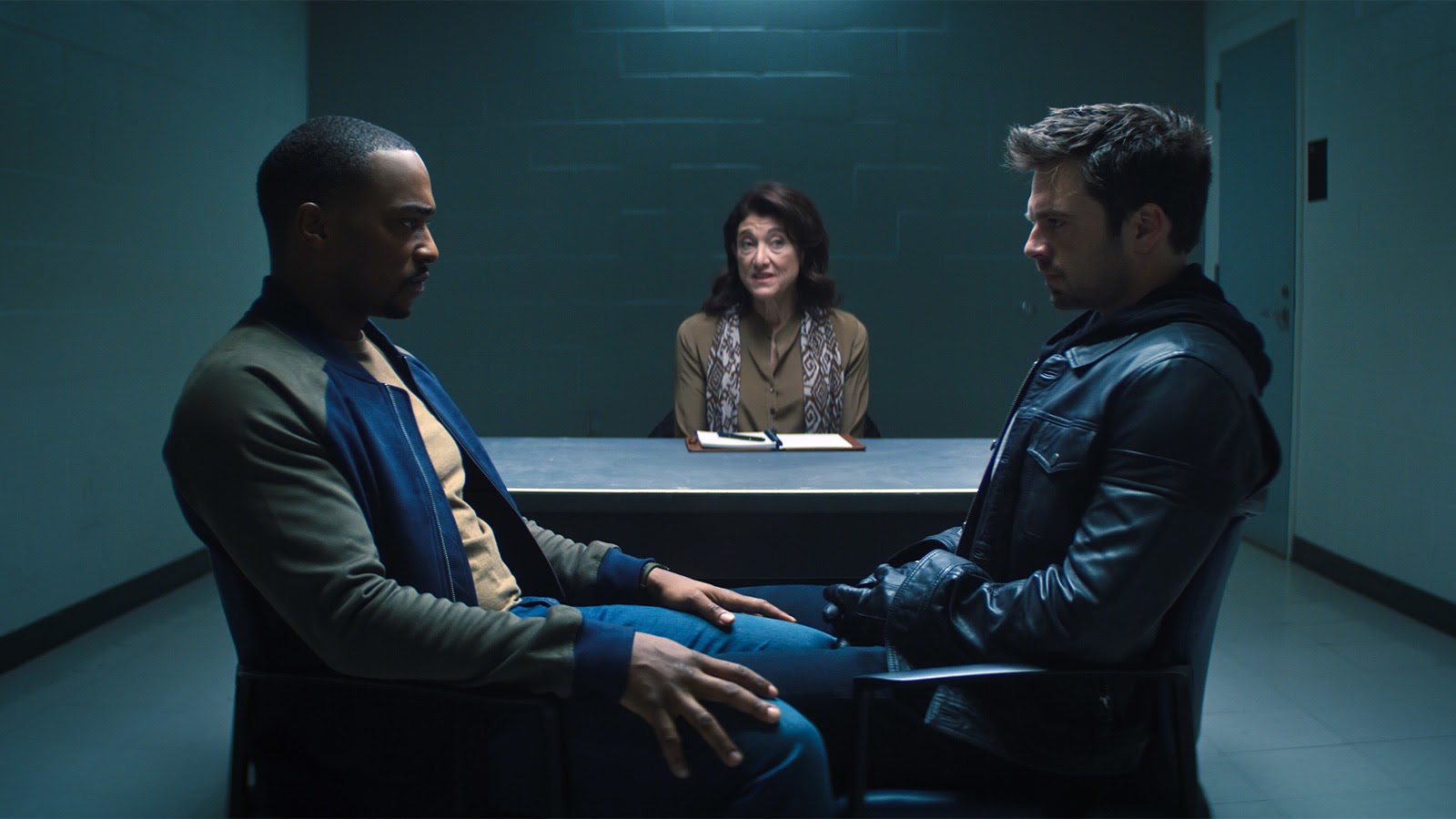
HULLFISH: Is the actual approach any different? Do you do selects reels for one and not for another? Or do you do selects reels for both, or neither?
TAN: I do it for both.
DESROSIERS: Yeah, I do it for dialogue scenes and then action scenes, depending on the volume. If there’s a tremendous amount, sometimes you have to do selects just because there’s too much archaeological digging involved sometimes. It happened on the thing I’m on right now where I’m thinking, “Okay, they have so much footage for this action sequence. I got to take three days and literally go through.”Because what’s happening more and more with limited time is you get four or five cameras.If you have five takes, it’s a five minute scene with five cameras for one take…you do the math.
I really need an extra day here to go through it all, and it’ll save you time downstream. Trust me.
Then, you have multiple takes and then you have multiple setups. I had a driving sequence that might’ve been 45 seconds at the end of the day, but there’s two hours’ worth of footage that you have to go through. So you have to do selects just to be able to have a frame of reference because you’re going to get notes on something so big and complicated.
It happens where they might say, “Do you have selects?” And I’ll say, “I’ve got selects for this part of it, that we have, I’ve got selects on the rabbit, I’ve got selects on the lead.” If you take the time, it saves you time. So, you just need to make sure that you’ll be given that time, saying, “Listen, you guys shot a lot of stuff so I really need an extra day here to go through it all, and it’ll save you time downstream. Trust me. And you’ll have a better sequence.”
TAN: Sometimes you don’t have time. Sometimes you’re told that we want to pull the stage for the next day. So, your dailies come in—I think it was for the finale, it was John Walker fighting on the street—and they’re literally losing time and they want to compress the certain section. The dailies came in by 4:00 PM because it was a night shoot, the dailies processing team were processing it, and when the assistants got it they had to prep it.
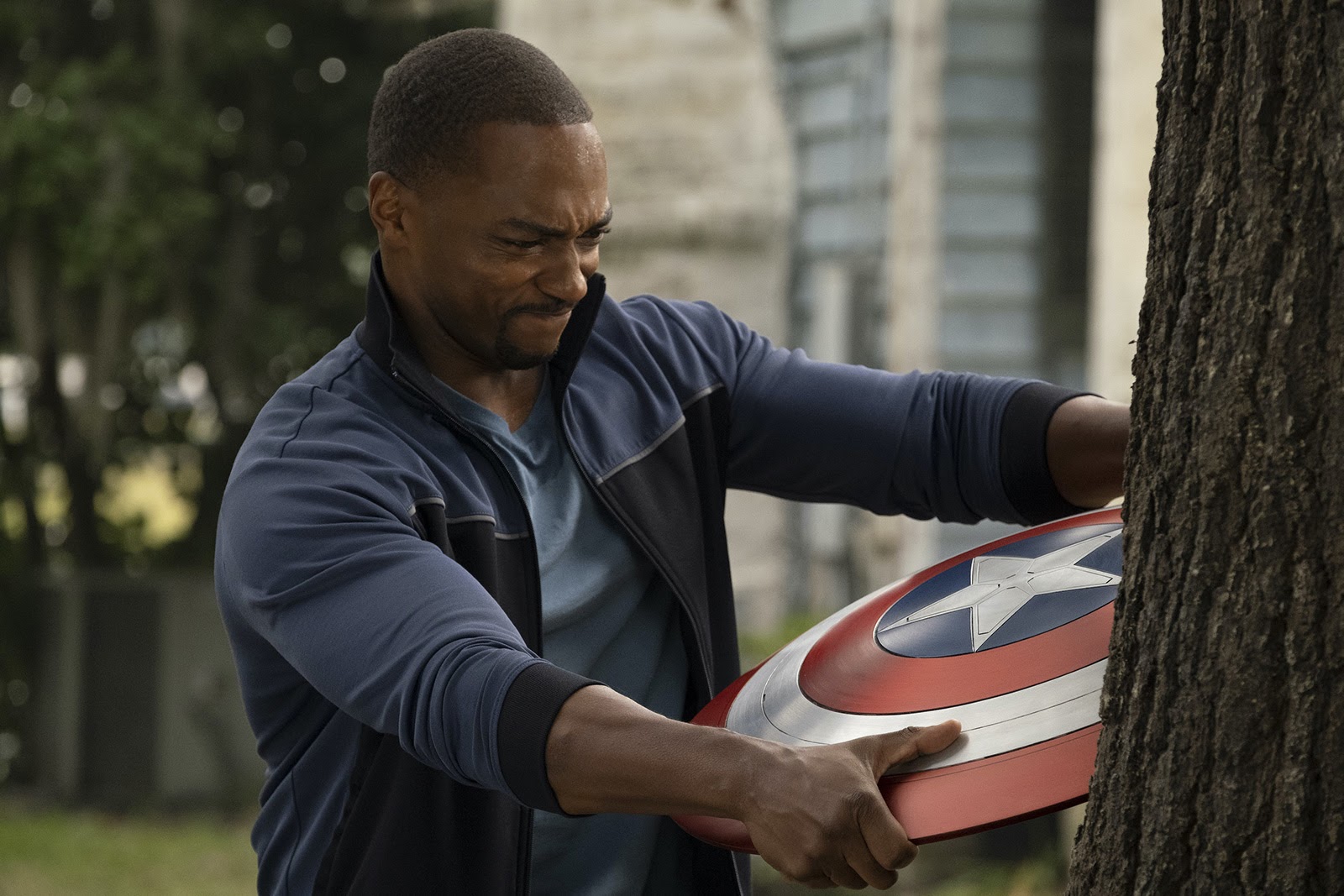
By the time I got it, it was about 3:00 PM, and I had to get it out by nighttime for their night shoot, just so they could see, “We won’t need this, this, this…” So, sometimes it’s just crazy-town as far as how much time you have, and you’re just doing the best rough sequence so that they can send it back to set for Kari to see if they need to pick this up or that up. I had a couple of days of that for the helicopter sequence too. They said, “We don’t want to shoot it any more on the stage. Show me a rough sequence of what you have.”
DESROSIERS: Yeah, that’s the thing. Or—it’s never happened before for me on any other thing—but they had three days in the beginning of five, that big giant fight sequence between Walker and Bucky and Sam, they did it over the course of three days. After day one, they said, “Hey, we’d love to see, and we know it’s rough, but we’d love to see something because it’s important for us to figure out so we could do this day.” As soon as it’s coming in, you’re trying to put it together.
This isn’t the final form. This is a rough sketch. It’s going to help you guys out.
That’s where the stunt-vis is super important because you have a basic framework and template that you have to meet and you can figure out really quickly if that isn’t working, but you don’t have time right now, you need to see something, so here you go. Then, there’s a phone call or there’s an email saying, “Hey, so here you go. You have it.” But it’s an understanding of: “This isn’t the final form. This is a rough sketch. It’s going to help you guys out on that day.” You don’t have time for selects in that, but hopefully you can double back, and we did. COVID helped give us some time to pull selects together.
HULLFISH: For previs, that’s generally a not-too-low-quality 3D. Is stunt-vis the performers in a stunt studio with a crappy camera?
TAN: They’ve actually got pretty good cameras. Sometimes they add wings and the shield. You gotta give kudos to that team. They do incredible stunt-vis, and it’s basically months of their planning. Then, they’ll add different angles and then they’ll add VFX to it. There’s an editor on their team that makes up cool stunt-vis. When we get it, it’s a great template, but then again, when dailies come in sometimes it just changes completely just because of circumstances. But it’s cool to see previs. Previs is all computer-generated stuff. A lot of times it’s just pretty incredible what they can do.
DESROSIERS: Yeah, there’s an art to that cut too in its own way. For Marvel though, they’ve had 10-plus years of doing it, so they’ve built that out. I haven’t seen it on any other TV shows, really. Maybe a standalone film or streaming shows, but they probably aren’t as sophisticated.
HULLFISH: The stunt-vis is live-action with real people?
DESROSIERS: It’s stunt actors in a warehouse stunt room with boxes standing in for trucks and crash mats and all that stuff, but there are specific characters. There’s a guy with a Captain America t-shirt, actually pretty stretchy shirts since they’re all pretty big dudes and ladies. What’s cool is sometimes you will see a VFX shield fling out, and the guy will react ‘cause the camera move is important. So, they’re trying to help figure out what the pacing for that sort of back and forth might be between the shield ricocheting off a bad guy and back to Cap.
It is pretty sophisticated. It’s really cool. You can also see where it’s not working in your opinion and they might have done the best that they can, and that’s the stuff that gets worked on. But it does really set a nice rough template up for you for the big, huge set pieces because it’s really necessary when you get down to it.
TAN: These are the same stunt guys that are going to be on set doing the same for those characters. So, literally seeing that and then seeing what they’re about to do is pretty incredible. They practice for months doing it.
DESROSIERS: Then, they might change stuff up on the day when they get there because Kari might say, “This isn’t working for me on a personal level, so let’s try a different tack.” Then, they have to just switch it up, or stuff got SNAFU-ed and so we’re in a different location than we’ve planned, or who knows? There’s a multitude of different reasons. Sometimes we say, “Okay, that stunt-vis doesn’t exist anymore. So put that away. Let’s figure it out.” But it’s impressive. I was thankful for it.
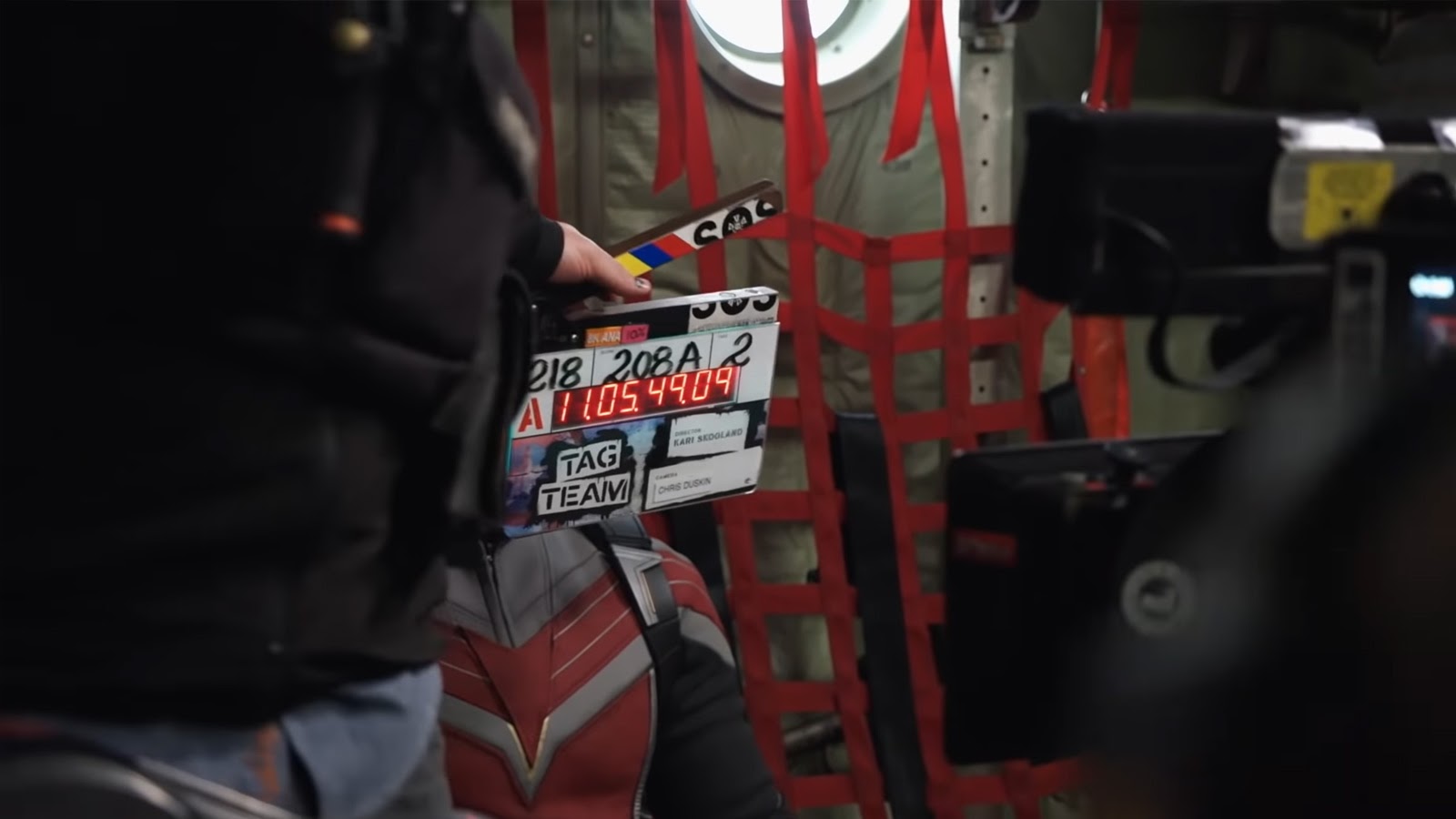
HULLFISH: What kind of schedule are we talking about with the shoot and with an editor’s cut and a director’s cut?
TAN: It’s a little weird on ours because of the shut down. We can’t really say. I’m so grateful that when the shutdown happened I was still in Atlanta, and then they said, “We’re shutting down. We don’t know what’s going to happen.” At the time I thought, “Okay, I’m going to go back to LA.” Todd was already in LA. I was the only team still in Atlanta. Then we figured out home systems, and it was almost right away. We were one of the first teams doing it, and, again, I’m so grateful that I get to keep working.
At that time we said, “We’re going to just fine tune what we have,” learning it for the first time ever with a new system. I think at the time we were doing a virtual box and it was a PC base. Then you have to learn your PC commands, but we were able to do it. It’s pretty incredible just to access media, although it was a little slower at the time because they were figuring things out, and we had a tech team on standby. We didn’t know but we hoped to start production at this time, and then they said, “We can’t start back up yet, so just keep fine tuning.”
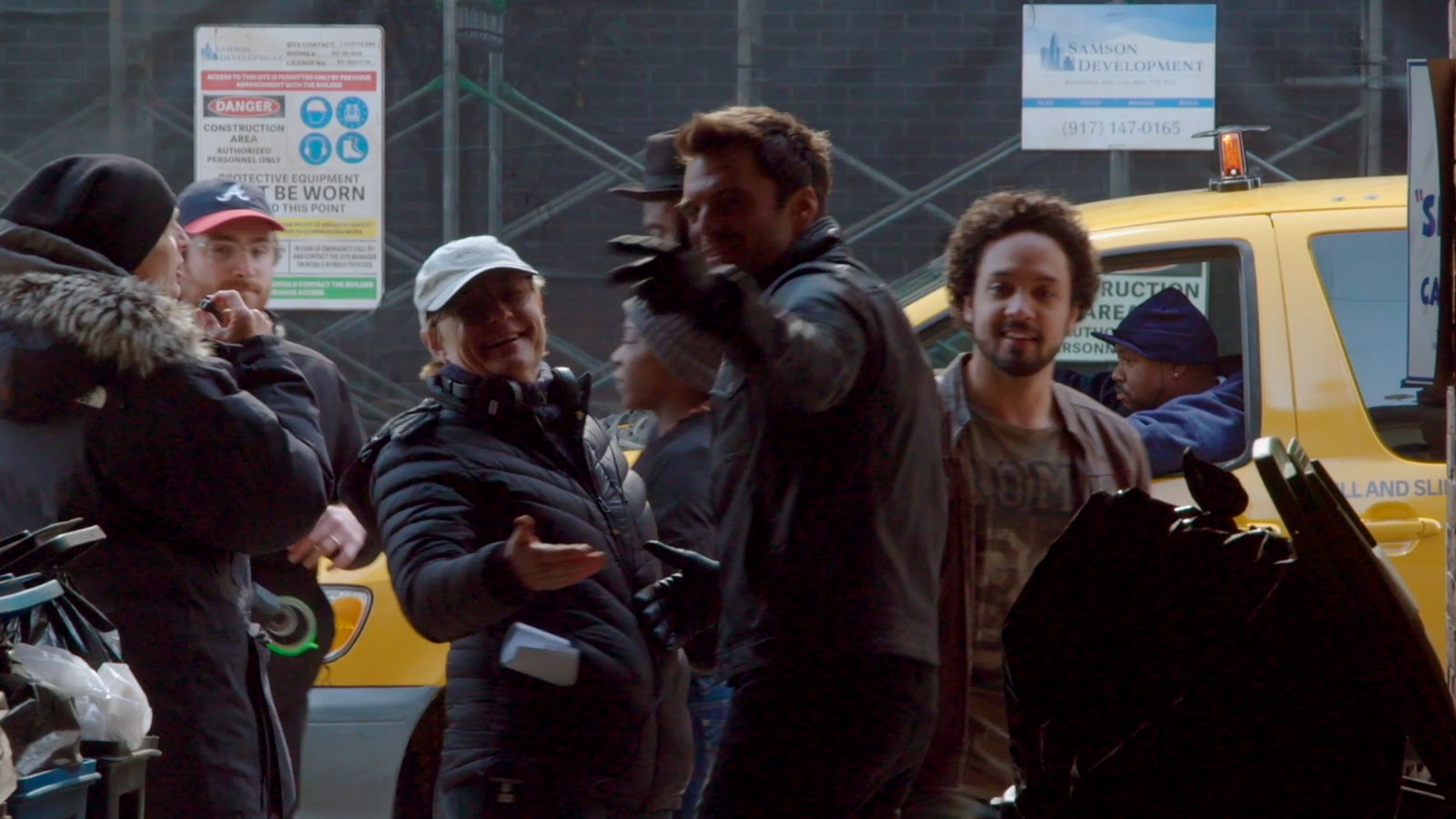
So we didn’t have a schedule and then suddenly, when they did plan production starting back up, it became an insanely small window. That’s why we’re so glad that Jeff Ford came in and we worked as a complete team. Whatever was problematic, we worked it out and solved it by trying this option, trying that option. At that time, I think we had a window of when things were being delivered.
DESROSIERS: Yeah, so it’s hard to say. There really was no traditional editor’s cut or director’s cut because of how everything got turned over. It just speaks to how good Marvel Studios is at rolling with it.
For the original schedule, we were supposed to go to Puerto Rico but there were earthquakes, so they couldn’t go there and had to stop. It’s a big army of people and machinery and storylines and that was supposed to be six weeks, I think. So, they said, “How do we pull the schedule up six weeks? What can we start shooting now?” Everybody just banded together and figured it out, and that was a foreshadowing for what was going to come.

Most of my episodes were almost shot when the pandemic hit. There were still big chunks missing, but it wasn’t supposed to be that way. I think Rosie, you were supposed to be next up for most of that Puerto Rico stuff, right?
TAN: Yeah. It was a lot of the shipyard stuff, the exteriors, and then a lot of six. Then they had to reshuffle and replan.
DESROSIERS: Then, while we had the shutdown we had a little time off because the world was trying to figure out what’s going to happen next, but, again, Marvel really just kept us in the loop and we didn’t feel like we were going to get abandoned and we were still part of Marvel.
Once they started and said, “We’re going to go for it,” it was a trial and error process, but we had the time. We were fortunate. We’re really one of the luckier groups of people to be able to keep forging ahead with it and take your mind off what was going on in the world. There was a lot going on in the world, at home especially. Then, the schedule reformulated, and once it reformulated then we realized, “Okay, we have a lot to do and the runway is tight,” and that’s when Jeff came in.
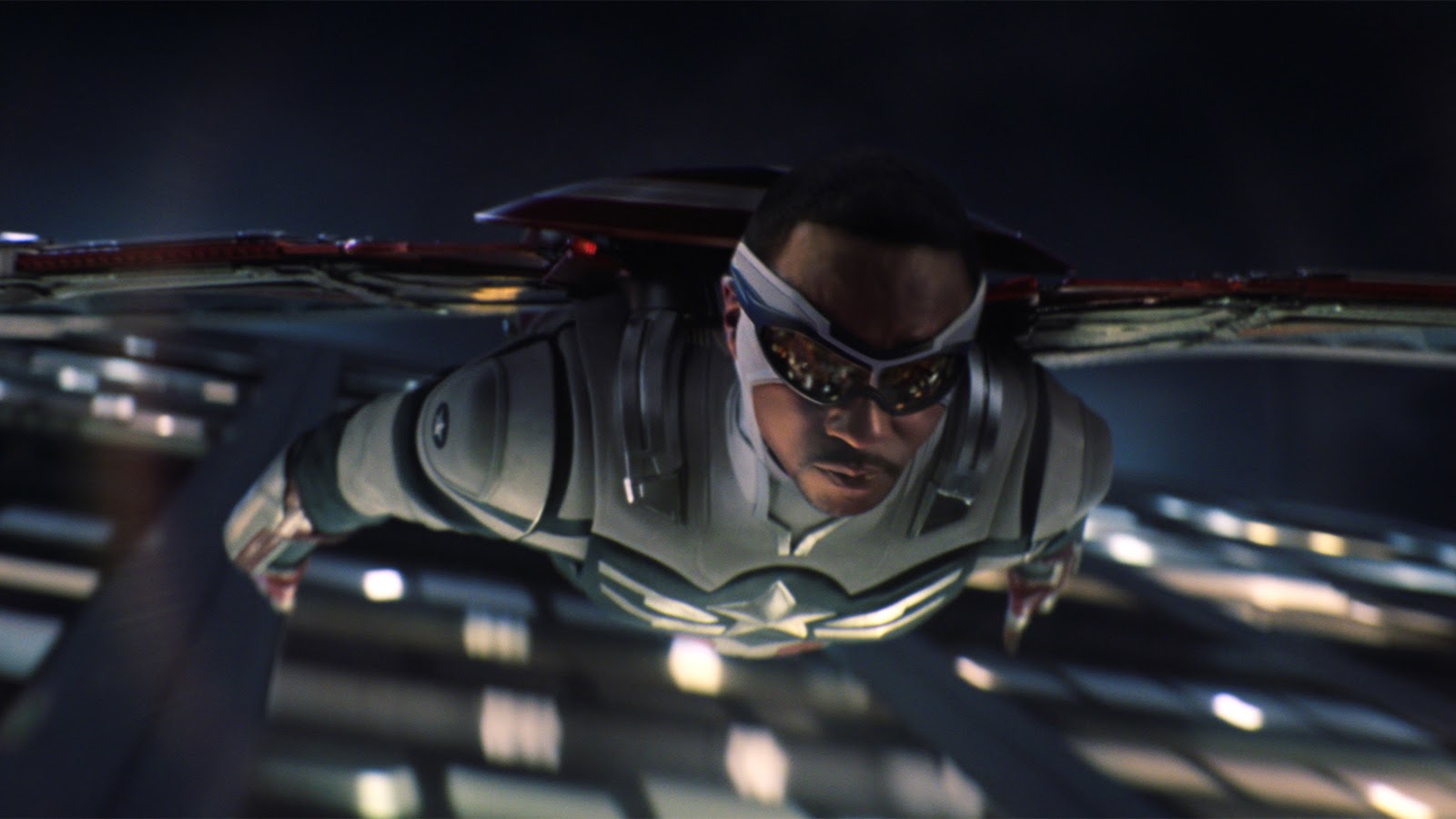
TAN: I think the finale episode was only about 30 percent shot or maybe 25 percent. For example, at one point, they said, “Build the sequence with storyboards and previs, or stunt vis, or just cards.” So, we built it and realized, “Yeah, this episode is mostly not shot.”
DESROSIERS: But then once the green light happened, and they said, “Let’s go to Prague and let’s finish shooting,” then Prague was having a second wave, so the schedule actually got shortened even further. So, whatever they planned on finishing up after many months of thinking about it and sharpening our pencils and making the best version of the story, they said, “Okay, we gotta rush it now because we’ve got to finish before we have to leave.”
So, there’s a lot of difficult moments that were put on the schedule and everybody, Rosie’s episode in particular, but we somehow managed to make something pretty special.
TAN: It was just a big, incredible team of lots of amazing people collaborating. Again, Marvel will never let anything go if they had an issue with it story-wise. We’re going to keep reworking, and that’s a good thing. You never once feel like, “Oh, this is going to go out subpar,” or anything like that. Nope, we’re going to keep working.
Sometimes we say, “Let’s put our heads together. Let’s all try a version of this.” That was the good thing, it was like a new format. Jeff was working with that format and I actually enjoy it. It was about, “How do we combine all of our versions together?” It’s pretty cool what comes out of it.

DESROSIERS: That’s where having the right people, not having an ego, and all that stuff—that was the start of this whole conversation—and just be open to, not the best idea wins, but everybody throws their idea in and if it’s not yours, it’s okay. Because the whole point is we’re making the best show possible. That was really crucial, and we got really lucky with the team that we had.
HULLFISH: Great art, it is said, is knowing when to stop. When do you know when you’ve worked on a piece and you feel comfortable letting it move to the next stage? How do you judge your own work to determine when good enough is good enough?
DESROSIERS: I didn’t like that saying, but I think they’re wise words. They have to pry it away from me. I always want to make another change, or I’ll always see something that I think is wrong with it, or I think, “I could’ve done this better.” Maybe it’s a perfectionist attitude, I’m not sure.
At some point, you run out of time. Or, they’ll say, “Oh, this is great. Put it in the show.” That happened a couple of times with Jeff, it was great to hear. I think I’d be better off leaving it up to other people to say, “Yes, this is working good,” because I think I’m too much of a perfectionist.
HULLFISH: So it’s the typical, “No movie is ever finished. It’s just abandoned”?
DESROSIERS: Maybe, yeah.
TAN: It’s a soft, soft lock.
DESROSIERS: Or a latch.
TAN: Oh yeah, a latch. It’s a latch. But I’m the same way, I’m really hard on my stuff. I’ll just keep working and reworking until late at night, drinking lots of coffee, and I’ll say, “Okay, I need to walk away because I can’t tell anymore.”Then, my assistant will look at it the next morning, and she’ll say, “This works.” I’ll say, “Really?” Because I would go down the rabbit hole of trying different things, thinking it doesn’t work. I’m thinking of alts upon alts, and then sometimes I’ll show Todd and he’ll say, “It’s fine. What are you talking about?” You’re your toughest critic, I guess.
DESROSIERS: It’s good to be that, but yeah, you run out of time. It’s taken away from you, abandoned. I think that’s probably more my philosophy.
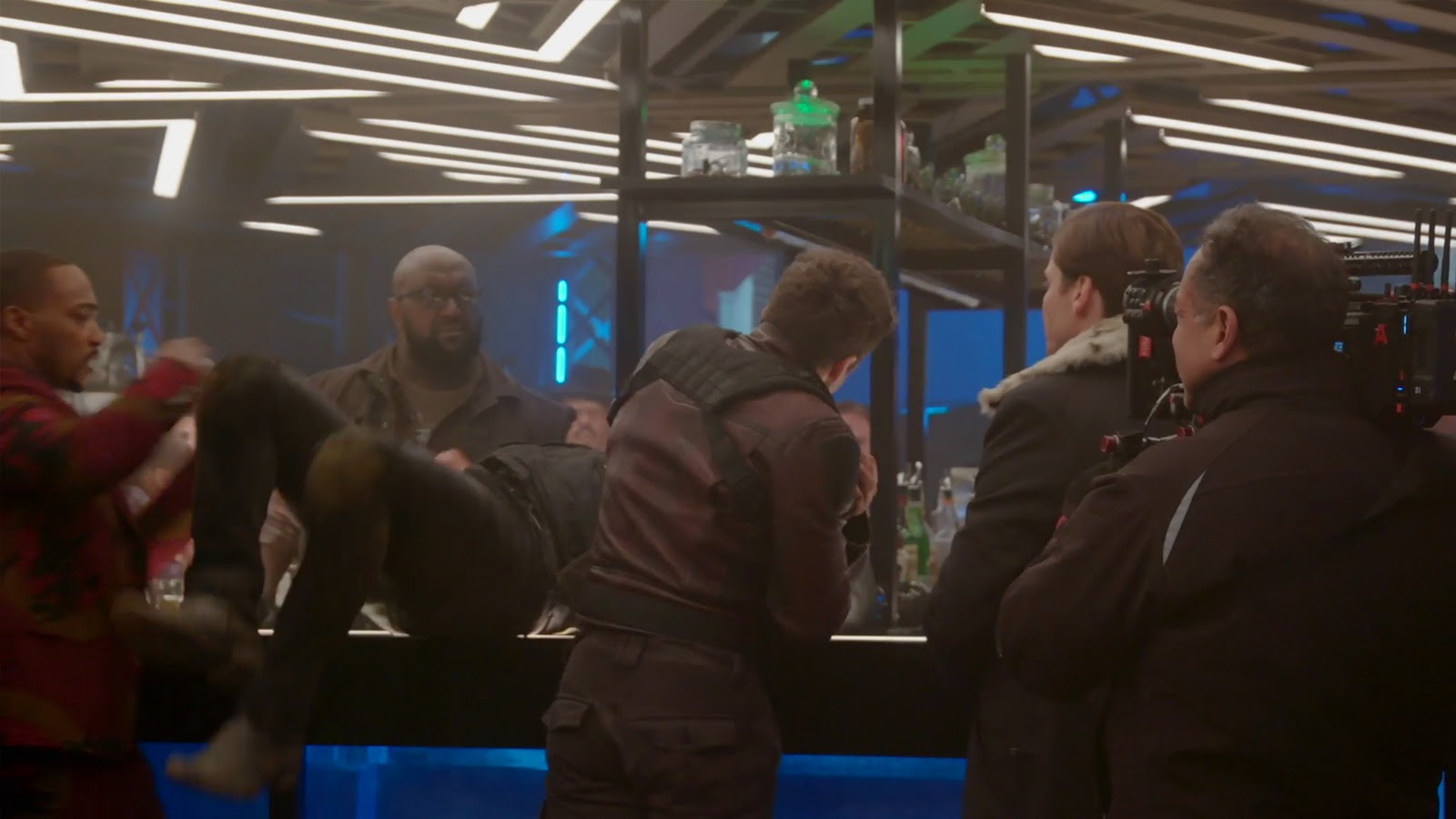
HULLFISH: What about judging other editors? One of the reasons we’re doing this interview is because of the Emmys. How do you look at somebody else’s work? You know how hard editing is and all of the variables that go into a good piece. How do you look at somebody else’s work and determine whether it’s award-worthy?
You actually need an award for the editing of that, because it was like, ‘Oh, my God. That was difficult. That was terrible.’
TAN: I usually try to watch more than just one episode, and then I want to see where that episode is. It’s so hard because you don’t know where they come from as far as what the dailies are on the day, or what the performances are, or what challenges they have. It is so tough.
DESROSIERS: I worked on some really, I’m not going to name them, but really difficult shows and it’s like, “This is so hard to make something mediocre out of this.” You actually need an award for the editing of that, because it was like, “Oh, my God. That was difficult. That was terrible.” The dailies were atrocious, that script is awful, and somehow it’s watchable. Wow.
HULLFISH: That editor deserves an award.
DESROSIERS: Yeah, those guys and women that do that stuff, tip your cap, but you’ll never know. That’s the thing, it’s an invisible art in that way as well that you’ll never really know.
TAN: It’s such an invisible art.
DESROSIERS: I think you’re right Rosie, you’ve watched the whole process. I mean, The Queen’s Gambit, holy cow, there’s some amazing editorial flourishes in that. I think Michele Tesoro did that, right?
HULLFISH: Yeah.
DESROSIERS: I’ve never met her, but gosh, I was really quite impressed with that kind of stuff.
HULLFISH: You’ll have to listen to the Art of the Cut interview.
DESROSIERS: I will definitely. I need time. I have a two-year-old so…
HULLFISH: Oh my goodness. Good luck with that. It’s been a while since I’ve had a two-year-old, but I remember those days.
I think fans and other people are really impressed with Marvel and the story intelligence and the knowledge of their own product with Kevin Feige and others that just seem to be obviously at the top of their game.
What’s the notes process like? Do you feel like getting notes at Marvel is different from getting notes on other shows that you’ve been on?
TAN: I like how kind everyone is and their notes process is actually very well thought out when we get documents. A lot of times Kevin, Louis, and Victoria know what’s coming ahead, but we don’t know. There are little gems that we’re not privy to at the moment in time, so they won’t say it.
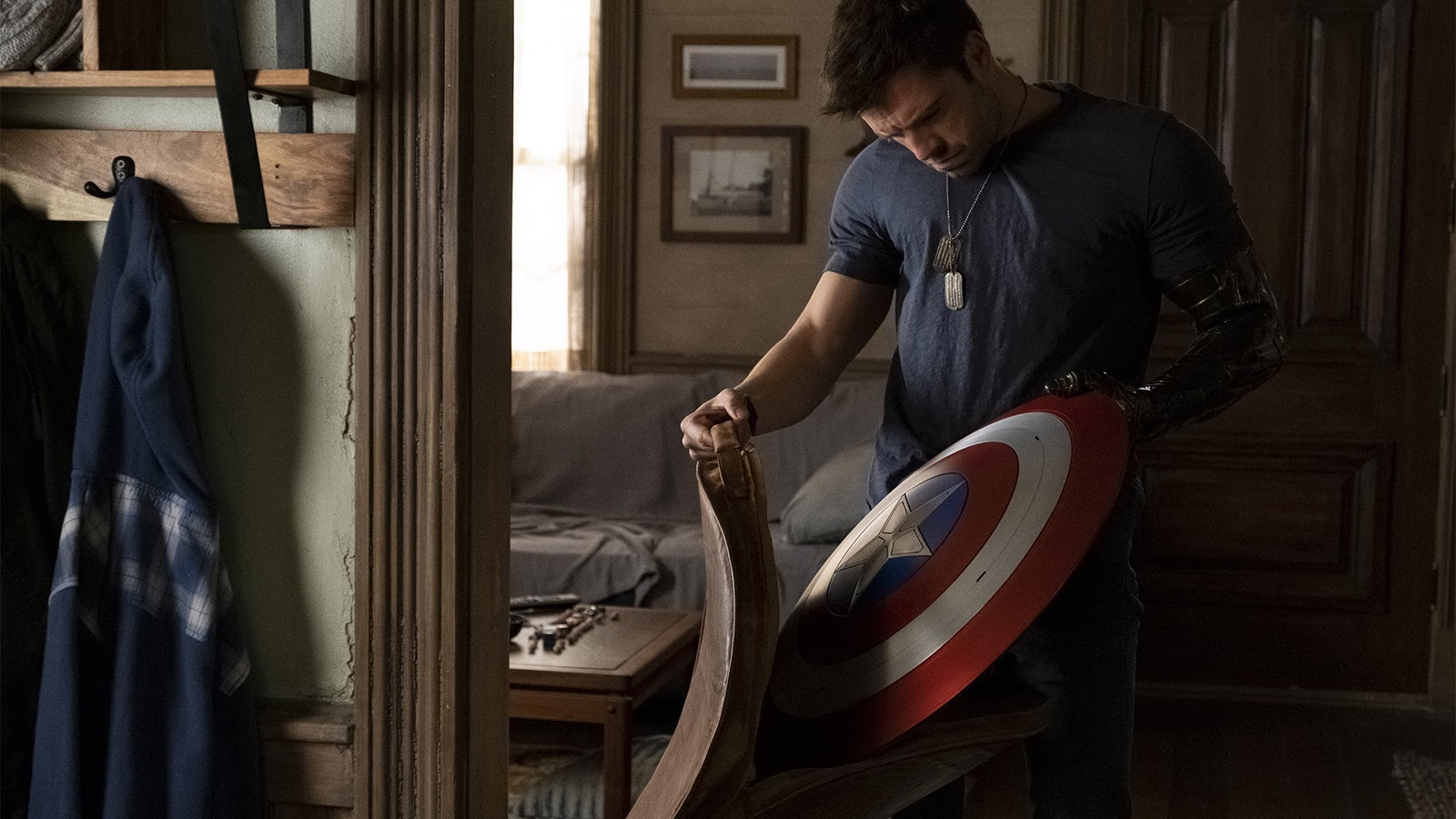
Again, the documents are so well thought out when we have meetings with them it’s really like, “This is not working because of this,” that we’re not thinking of. I’m grateful that this is such a big universe. I’m so happy to be part of the machine, and they’re so kind. I think at the beginning of joining this, I wasn’t sure if we’re going to work with Kevin, Louis, Victoria, and the team, so then to be able to have sessions with them, it makes me think, “My gosh. We’re really working with them.”
Unfortunately, because of COVID, we were all on Zoom. So, I’m literally in the box. Hopefully, one day we’ll work in person, but I just love how elaborate the notes process is. If something isn’t working out, we’ll all talk about it, and then the next thing you know we’ll get another stack of notes, and after a discussion, they’re willing to solve things or try things. There are just many passes of asking, “If something’s not working, why isn’t it working? Let’s ask a few different people for their opinion,” and we’re just trying it. Then, we’ll go to our internal team and then we’ll work out how we’ll all try this version and then we attack it that way. So, it’s really collaborative and different, definitely.
DESROSIERS: I think early on, that was one of the main reasons I was really happy to jump on working for Marvel Studios just because obviously what they’ve done is pretty amazing, and they’re the same people that have been central in Kevin, Louis, and Victoria.
It’s just far less intimate and far less like spitball, especially for early ideas. So, that was something that COVID took away.
As Rosie was saying, they know what stuff is coming, but they’ve been working on this stuff on the script phase for years before we even are coming in and watching dailies. So, they know it way more intimately than us, which is pretty impressive. I thought, “Wow, I get a chance to work with these people, and they’re so good at what they do. It’d be an amazing opportunity.” We had Jen Bergman, who was our post producer in Atlanta, and we had Tristan Mathews here in LA and he was awesome. Tristan was new to Marvel too, but Jen had been working on it forever and she said, “Oh yeah, Kevin will be in the room with you guys. You’ll be working and he really loves the post-process.” So, I thought, “Wow, this is really great.”
So, as Rosie said, COVID changed that and it became a Zoom session. That’s fine, it’s just far less intimate and far less like spitball, especially for early ideas. So, that was something that COVID took away in a sense. That’s when Jeff came on. Then, we had someone we can work with intimately every day, and something like that was really special.
Having said all that, I’ve been looking forward to the notes process from those guys from day one. It was awesome. The insights and how well Kevin really knows these stories and what he wants, and he has such a laid-back approach and a really funny sense of humor. So, it’s not a painful process at all. It’s actually kind of fun.
HULLFISH: I think of some of the less-experienced producers or directors that I’ve worked with and how I might push back a little bit more against them than I would somebody else. I would think, “I don’t know if I would push back on any idea,” but you must have, right?
DESROSIERS: That’s what they want actually. They don’t want you to just say, “Yes, sir. No, sir.” The thing is, because of the nature of it, the paper notes would come in and you try some stuff and then you think, “This isn’t working for that kind of thing or that reason.” So, then once you get everything up on its feet and you’re getting to a Zoom session and a last looks moment with them, they were understanding if it wasn’t working.
TAN: You just show them alts.
DESROSIERS: I’ve always tried everything. I’ll never say no. I learned early on: don’t say no. I had a mentor-director that I worked with a while back who used to edit. There were a couple of times where I said, “I can’t do it. I can’t do that now. There’s just no way.” Then he would get in the room with me and about an hour later we did what he asked. He just saw it in a different way, and I learned pretty early on: don’t say no. There’s always a way. Be open to it.
I learned early on: don’t say no.
HULLFISH: That is a huge tip because I agree that there have been, not very many times, but it had happened where I said, “This note is not going to work. There’s no sense even wasting my time on it.” Then, being forced to do the note and having it work great, and you think, “Ugh, now I look like an idiot.”
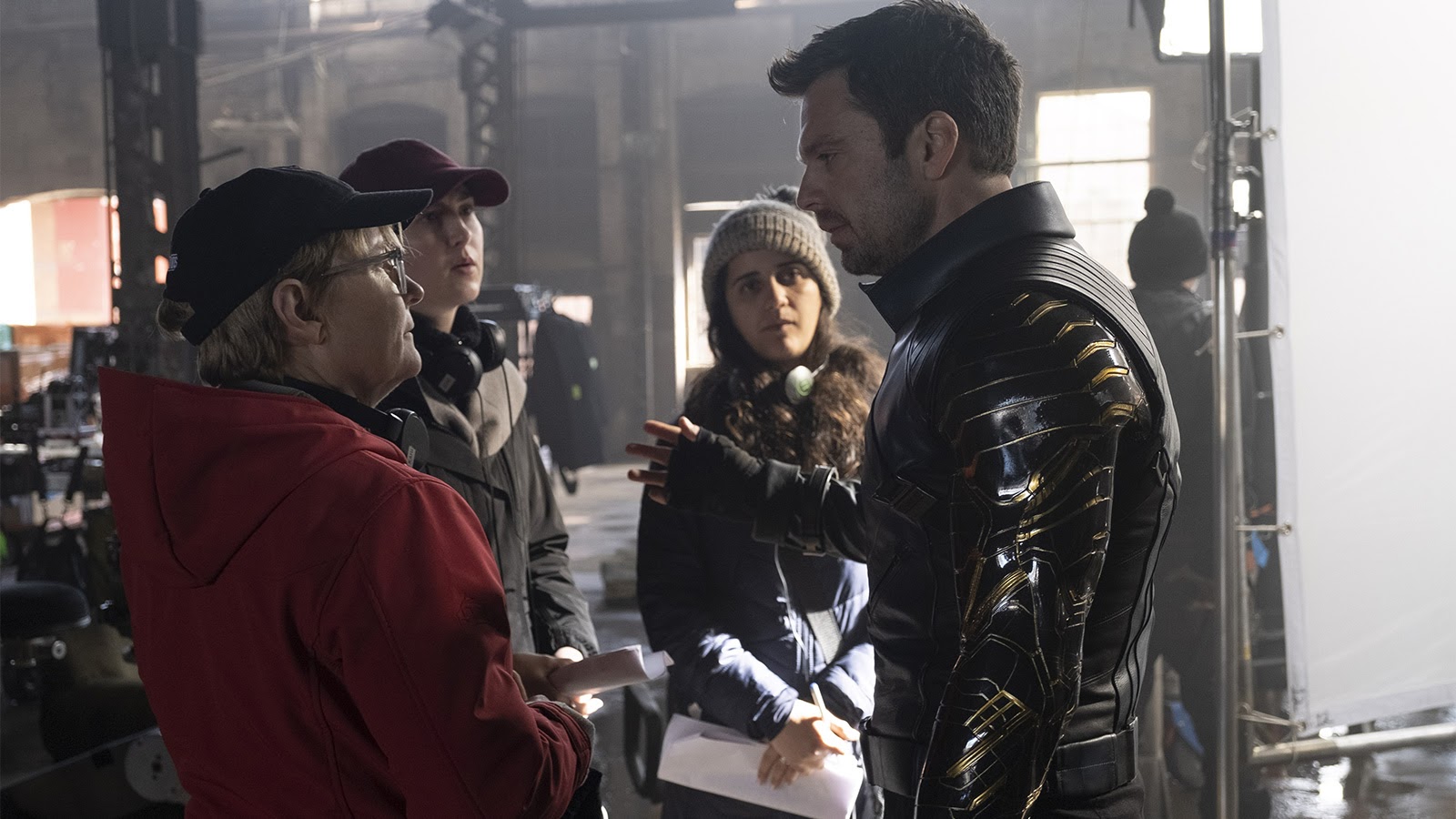
DESROSIERS: Yeah. Even if there’s a note you don’t agree with—at some points Jeff didn’t agree with it—we would do it and we’d have it because if Kevin wanted it, it’s going to go in. But you’d fight for it and they want you to fight for it, for your point of view. It might be wrong and they might humble you, but they want you to fight for it because that means you care.
TAN: Yeah, and just show options. If something isn’t working, show them why. For example, you could go down a different rabbit hole of the wrong versions and it’s okay. We’ll just put it aside and we’ll keep trucking on moving in the right direction, and you won’t know that until you actually try it. Like you said, sometimes you’re thinking, “I don’t know if it’s ever going to work,” and then you try it and you think, “I’m glad I tried it and I didn’t say something or be resistant.”
Working with Jeff Ford and his first assistant, Robin Buday, who have both done all these different movies and just picking their brains on stuff, sometimes we’re showing something and Jeff knows the character so well, he’ll just tell us right off, “This is probably not… Let’s try this.” So, it’s really great to have the internal team that way.
He knows the process miles ahead and why your idea might be difficult based on what’s coming.
DESROSIERS: Yeah, he is someone you could show it to early on and he’ll let you know if you’re in the right direction or wrong direction and tell you why it’s not working. That was super helpful too. Especially the big action sequences and also the visual effects stuff where he knows the process miles ahead and why your idea might be difficult based on what’s coming. It was rare because they don’t want you to get locked-in based on something like that, but it can happen.
Also, we’re dealing in a new paradigm of all email-based now. It’s not face-to-face anymore. You can take something the wrong way and then you’re moving down the wrong avenue based on someone misreading something. So, let’s really get our end of things tight, and then we’ll move on from there. That was a really crucial and important way to go about it, and I think a lot of people are probably experiencing the same thing on their own because there’s a lot of working from home going on right now.
TAN: Every team was different, but for us, Tristan Mathews, our post supervisor, was great about organizing meetings for everybody so that we were always in communication. I feel like sometimes we maybe have too many meetings but it’s not just with him, it’s just with other teams also. Where it used to be in pre-lockdown was you can just walk to somebody’s room and just get the answer. Whereas, now you’ve got to make an appointment for that meeting and then this other meeting, but, again, I’m grateful for it because then we can just go down to ask the question on Zoom and just click and we’re there. But Tristan would plan those meetings with all the editors and assistant editors and we were just talking it out.
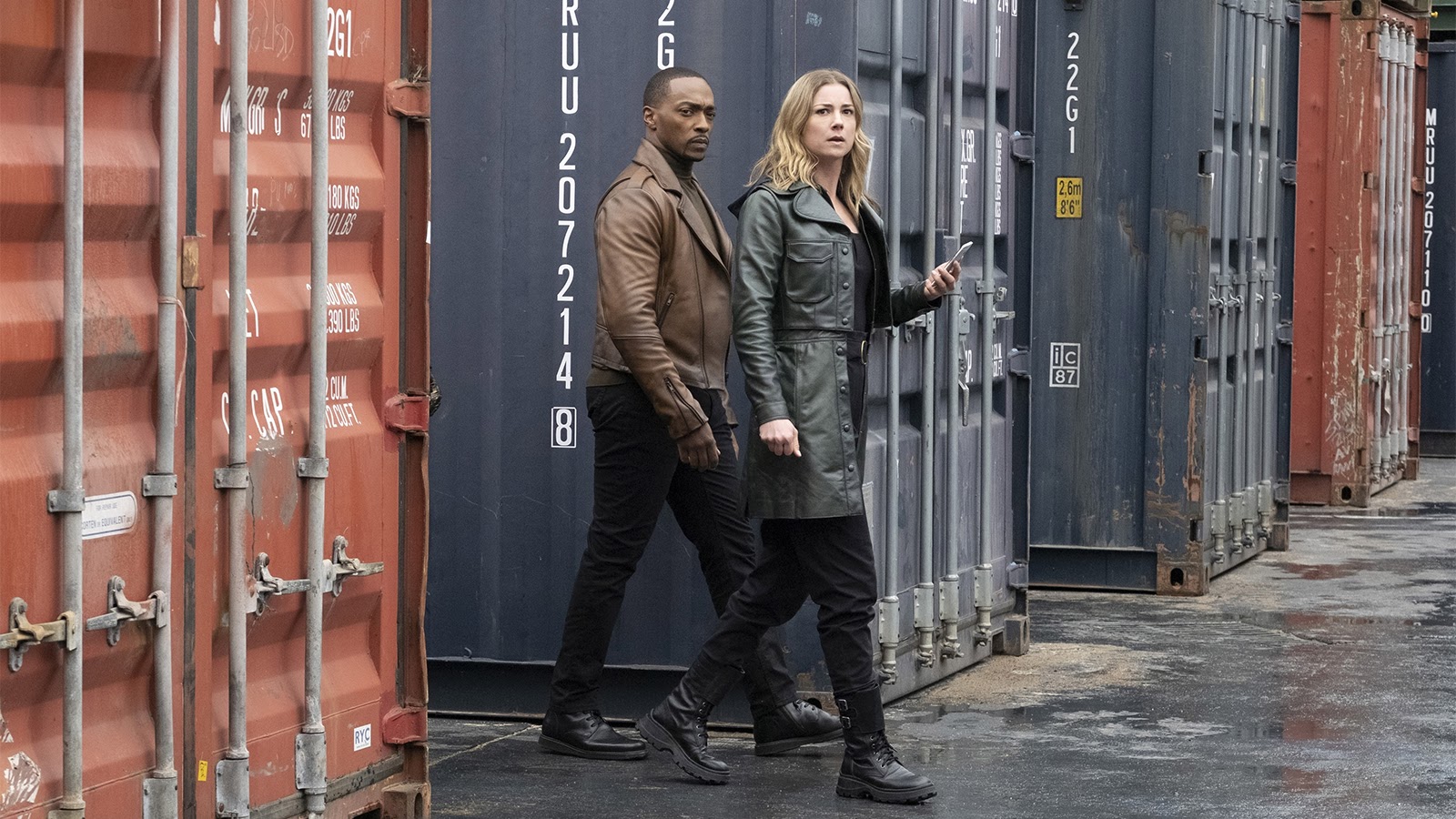
DESROSIERS: The other thing too is in early days, they’d have these catch-up Fridays, and they didn’t last just because of the nature of things. If you’re on eight hours’ worth of Zoom calls, as it got towards the end, the last thing you want is a catch-up Friday. It was also really important, I think, especially early days where it was about keeping the human side of this, the part where you would see each other in the kitchen and you chit-chat to catch up and see how people are doing on a personal level.
Tristan was one of the people that helped architect that kind of thing, and that was really crucial, especially in early days when there’s so much stress going on about what’s happening, wondering, “Am I going to get to go outside, hug my mom again?” I do maintain, maybe we were lucky, but it felt like a family there. I think Marvel is pretty unique in that it’s a massive enterprise, but at its heart it feels like an independent movie company. There is a family nature to it.
TAN: When we were in Atlanta, Jen Bergman, our production post supervisor, would always set meetings there in person too. We would see the WandaVision guys down the other side of the building and it was cool. It made us think, “Oh my gosh, what’s happening over there?” Then, let’s see the Loki team.

DESROSIERS: There’s a collegial sort of thing. It was like a super friends sort of place to go because they were always there. They’re at their wing, you can only go so far and you can’t ask too many questions of each other, but you can talk about, “Oh, that’s cool, blah, blah, blah…” chit chat over coffee. That was awesome. That was really unique too. I mean, it’s going to come back, but right now it’s done like this.
HULLFISH: Guys, thank you so much for your time. I certainly appreciate everything you had to chat about. Thank you.
TAN: Thanks for having us.
DESROSIERS: Thank you. You made it easy. You’re a pro.

